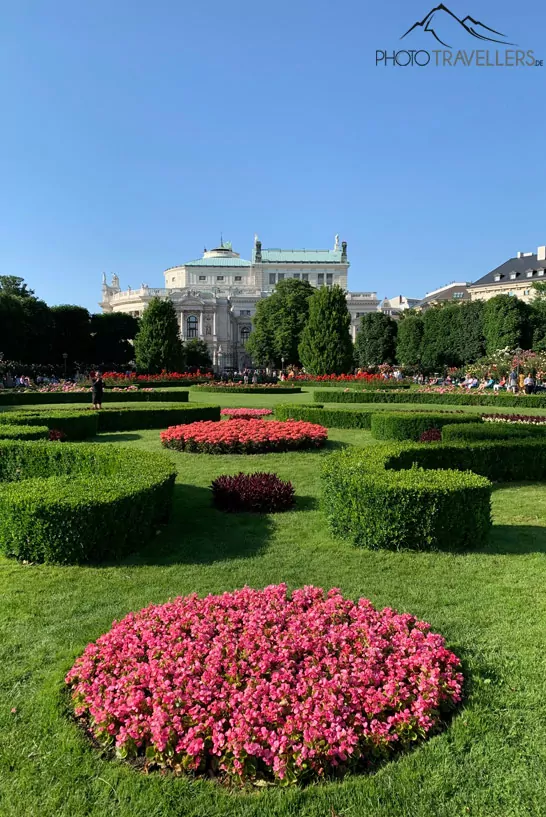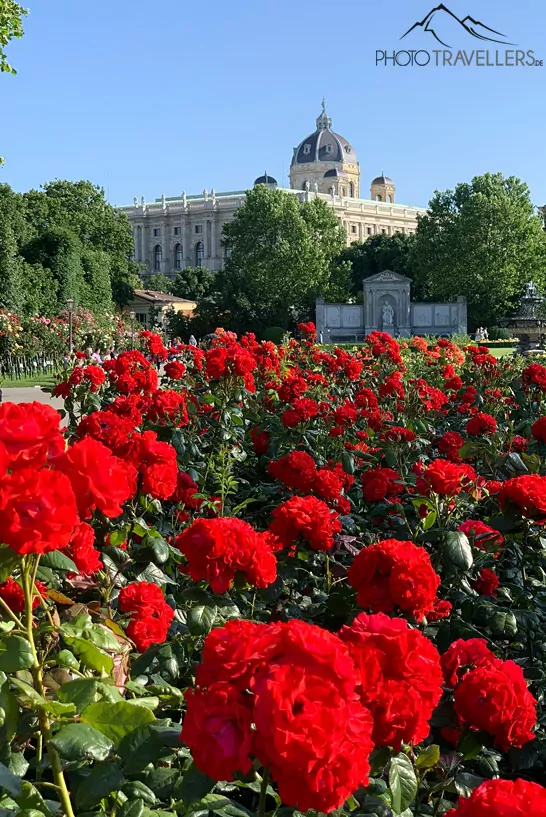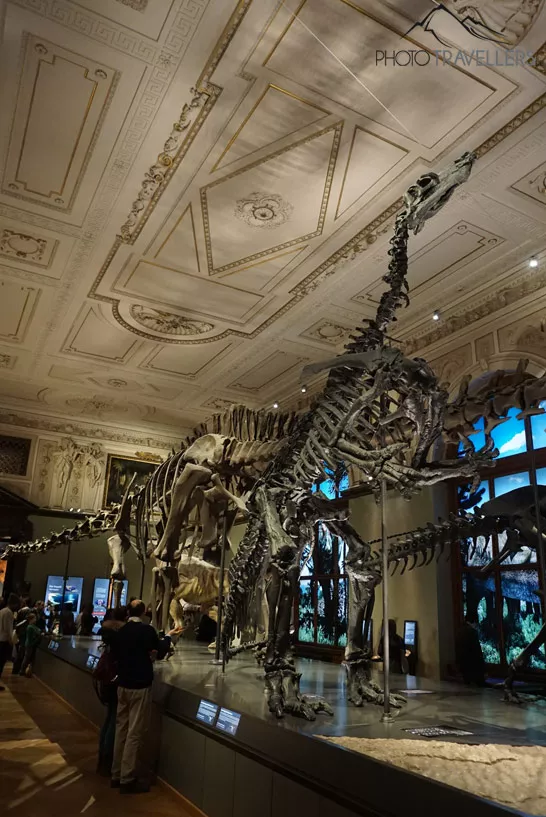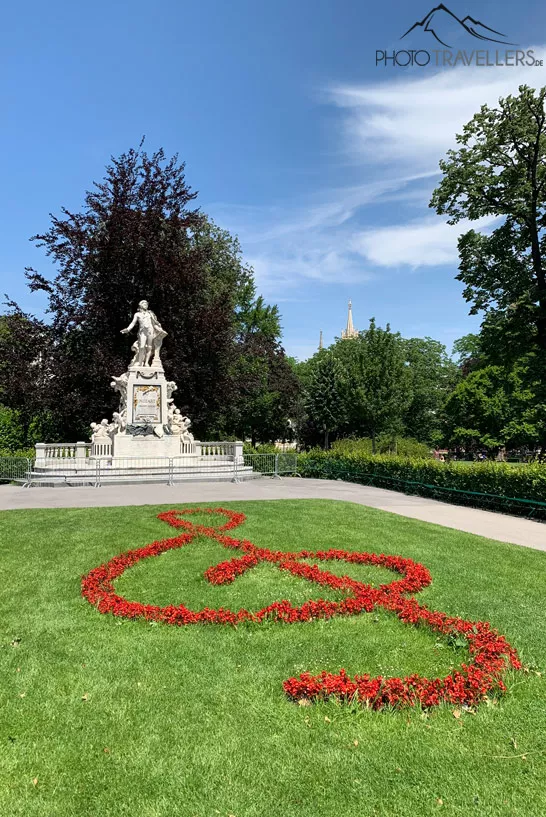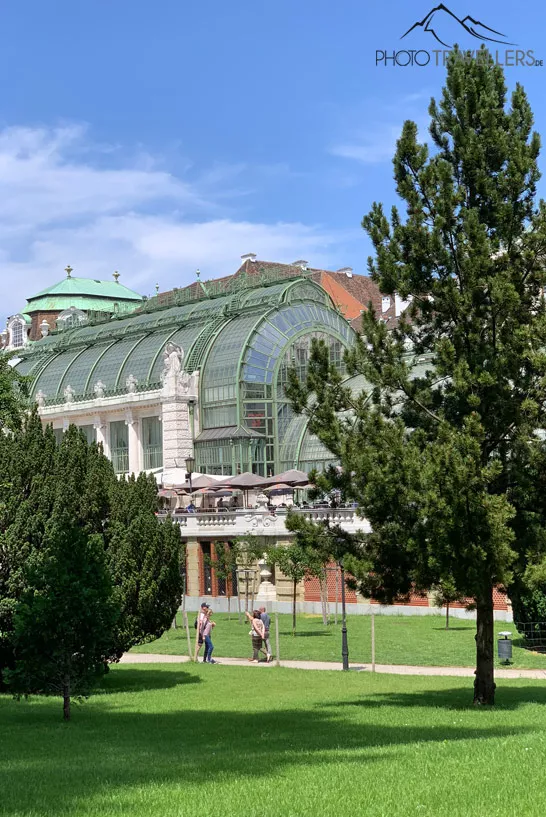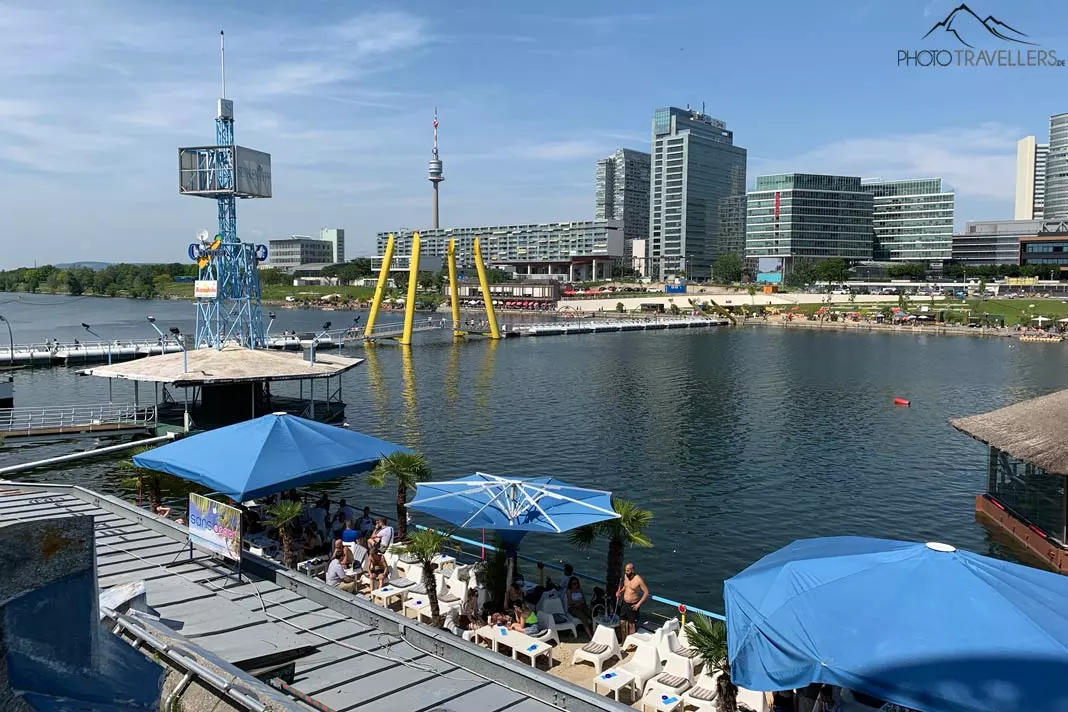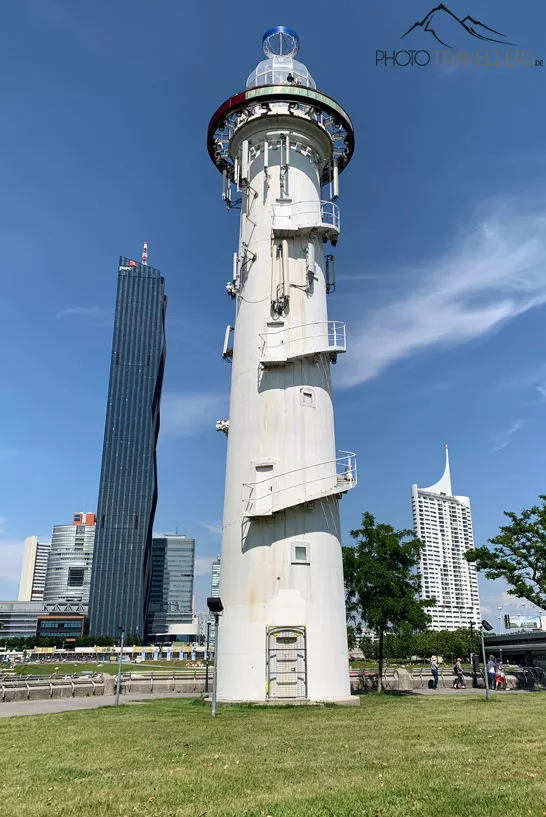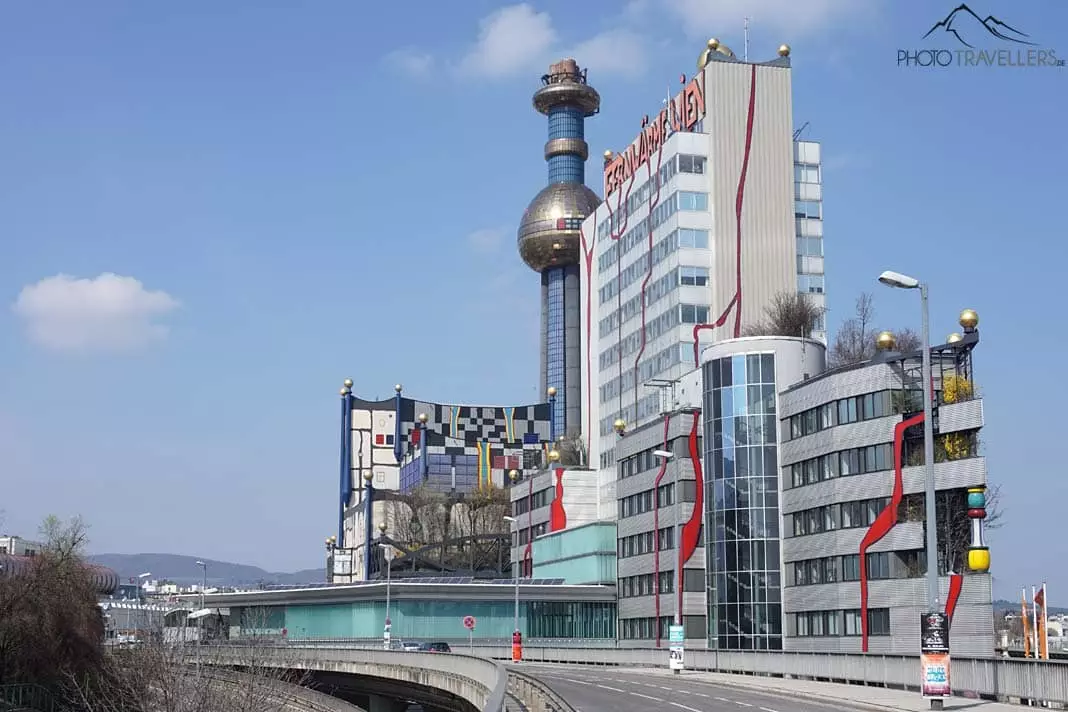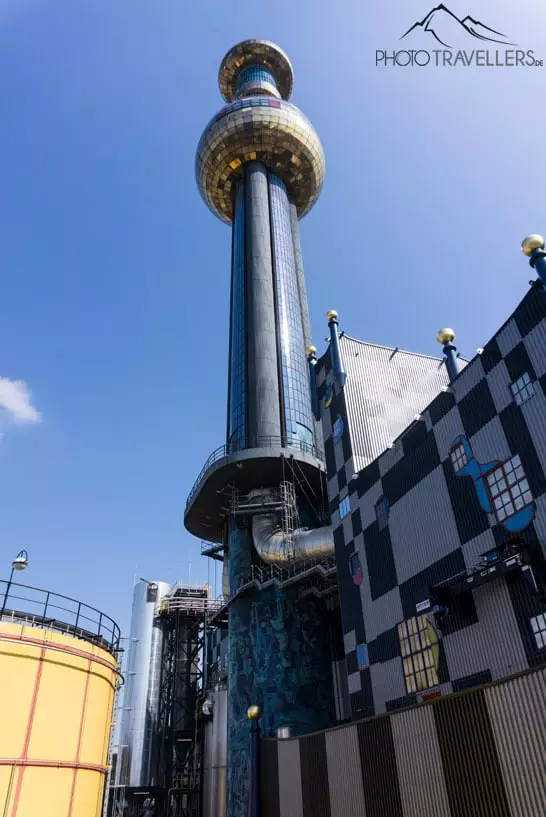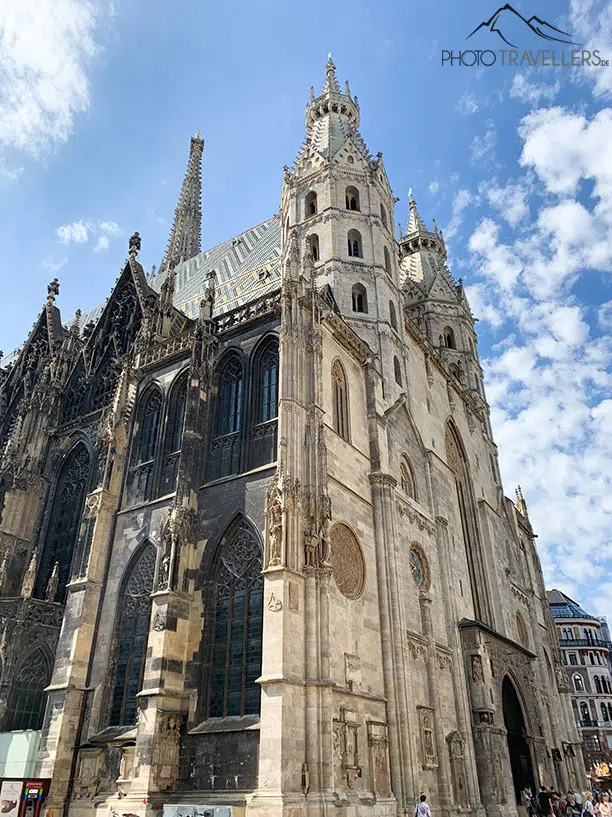
Top things to do in Vienna: 24 beautiful sights to see [+ map]
Vienna is Austria's capital and has more than 1.8 million inhabitants, making it the largest city in the beautiful Alpine country. For visitors, the city has some famous sights, such as Schönbrunn Palace, the Naschmarkt, Hofburg Palace, and St. Stephen's Cathedral.
In this article, we present to you the most famous top sights in Vienna. Spending several days in the city will also find some insider tips in addition to the top highlights. Have fun with our foray through the beautiful Danube metropolis.
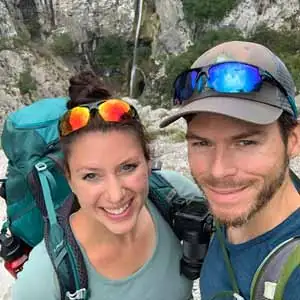
Hi! Wir sind Biggi & Flo
Wir nehmen dich als Reisejournalisten mit zu den schönsten Orten der Welt!
Werbehinweis: Alle mit einem * markierten Links sind Werbelinks.
Our Top 24 Sights in Vienna
First of all, here’s an overview of our top 24 sights in Vienna.

- Schönbrunn Palace with zoo
- Hofburg Palace
- Ceremonial room of the Austrian National Library
- St. Stephen’s Cathedral with the catacombs
- Capuchin crypt
- Prater (Wurstelprater)
- Vienna City Hall
- Belvedere Palace
- Naschmarkt
- Karlskirche
- Hundertwasser House
- Kärtner Street with the Hotel Sacher & Sacher Torte
- Parliament
- Votivkirche
- Volksgarten
- Natural History Museum
- Museum Quarter Vienna
- Art House Vienna
- Central Cemetery
- Albertina
- Monument to Mozart in the Burggarten with Butterfly House
- Anchor Clock
- Oldest church in Vienna – Ruprechtskirche
- Danube Island
Tip: if you want to visit Vienna and all the important sights much cheaper, there is the Go City Pass Wien (get it here*).
Map: All Vienna sights at a glance
On our interactive map you can find all Vienna sights at a glance.
[mapsmarker map=”51″]
1. Schönbrunn Palace with zoo
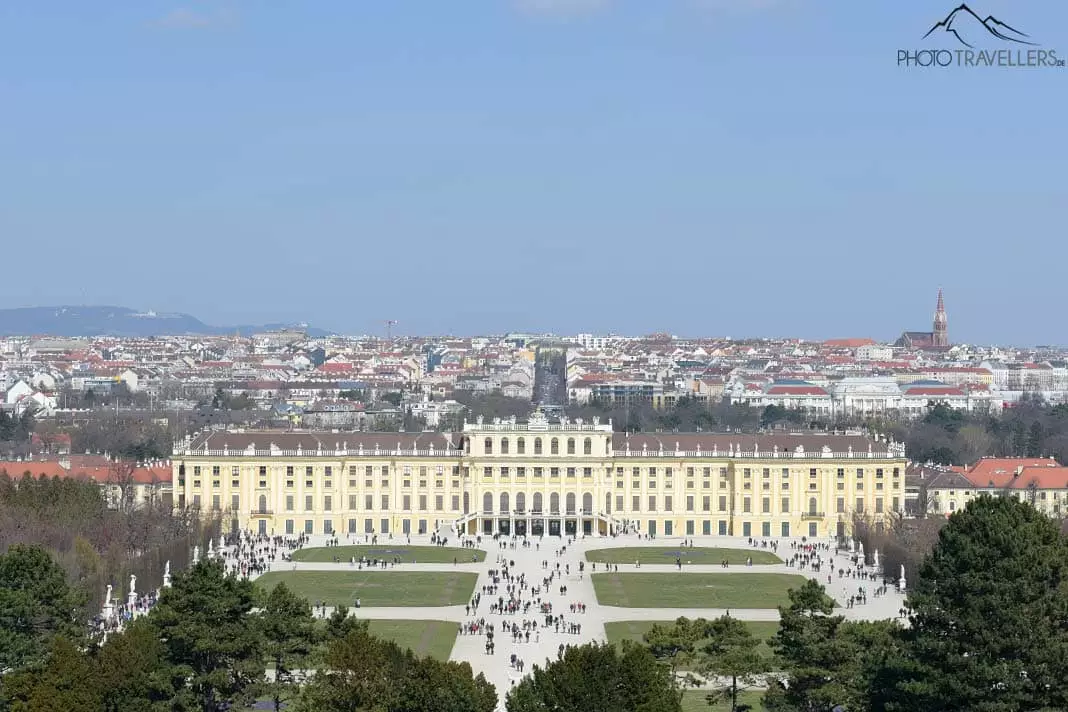
Schönbrunn Palace is without a doubt one of the top sightseeing attractions in Vienna. The World Heritage Site is Austria’s most visited attraction. The baroque palace and the huge palace garden were owned by the Habsburgs for centuries and were the summer residence of the imperial family.
This is where Emperor Franz Joseph and his Empress Sisi, as she was affectionately known, resided. The emperor reigned from 1848 to 1916. We are absolute Vienna fans and enjoy every time to stroll here on the grounds at this beautiful place.
Schönbrunn Palace invites you to take a trip back in time – after all, the entire complex is still largely in its original historic state. Schönbrunn Palace is simply a must-do.
Admission to the palace gardens, where you can easily spend half a day, is free. However, if you want to visit the huge ballroom or the bedroom of Emperor Franz Joseph, you need a ticket for the palace.
Our tip: If you don’t want to wait in line for hours, you should order your tickets in advance on the Internet.
Another cool attraction is the Schönbrunn Zoo. The oldest zoo in the world is located in the middle of the imperial summer residence. However, we personally are not friends of zoos – but everyone has to decide that for themselves.
Price: Adults pay 16 euros for the famous Imperial Tour (22 rooms in about 35 minutes) at Schönbrunn Palace. The famous Grand Tour (40 rooms in about 50 to 60 minutes) costs 20 euros per person. With the Vienna Pass* you get free access to Schönbrunn Palace.
2. Hofburg Palace
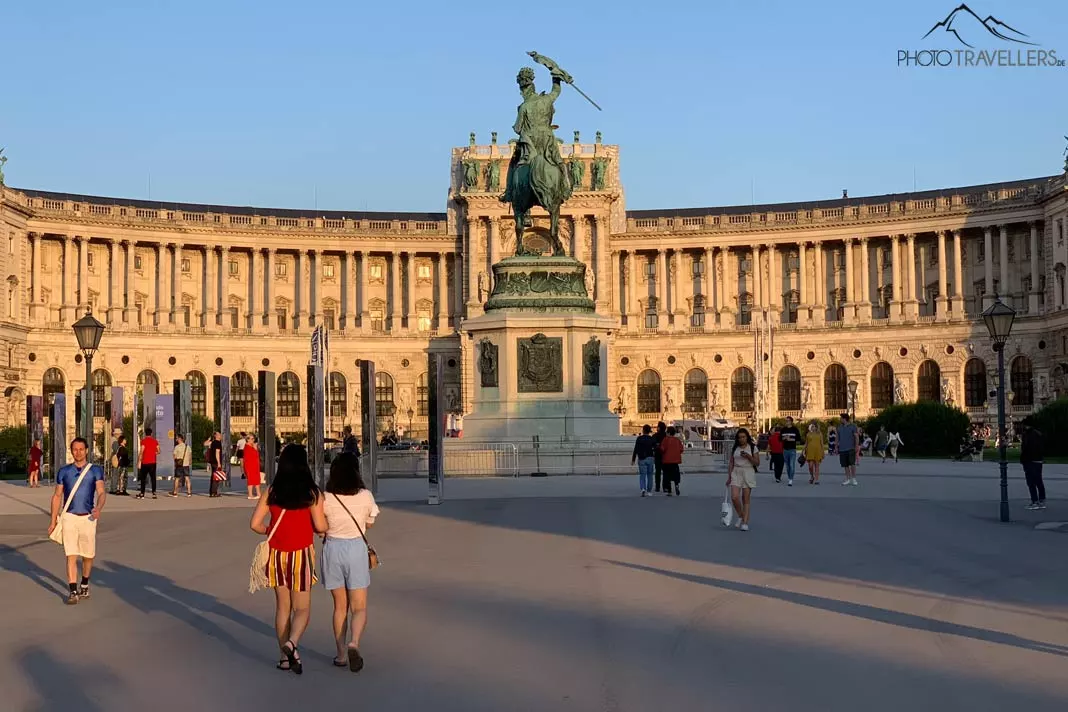
Here we have another great highlight in Vienna: the Vienna Hofburg was the center of the Habsburg sphere of influence for centuries. Until 1918, the castle complex was the political center of the monarchy.
Honestly, when you stand in front of the building, it leaves you speechless. It is already very pompous and undoubtedly one of the places in Vienna that you must see.
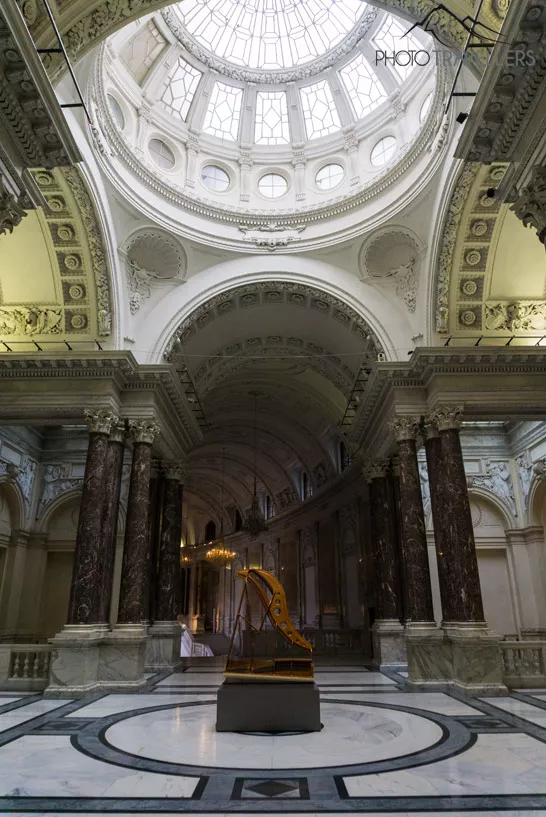
Today, the Federal President, the Minister of the Chancellery, and the Secretaries of State of the Republic reside in Hofburg. In addition, the Hofburg houses institutions such as the Spanish Riding School and the Austrian National Library.
Sisi fans should head for the Sisi Museum. But also, the Imperial Apartments and the Silver Chamber, a comprehensive collection of imperial utensils, can be visited and will fascinate you.
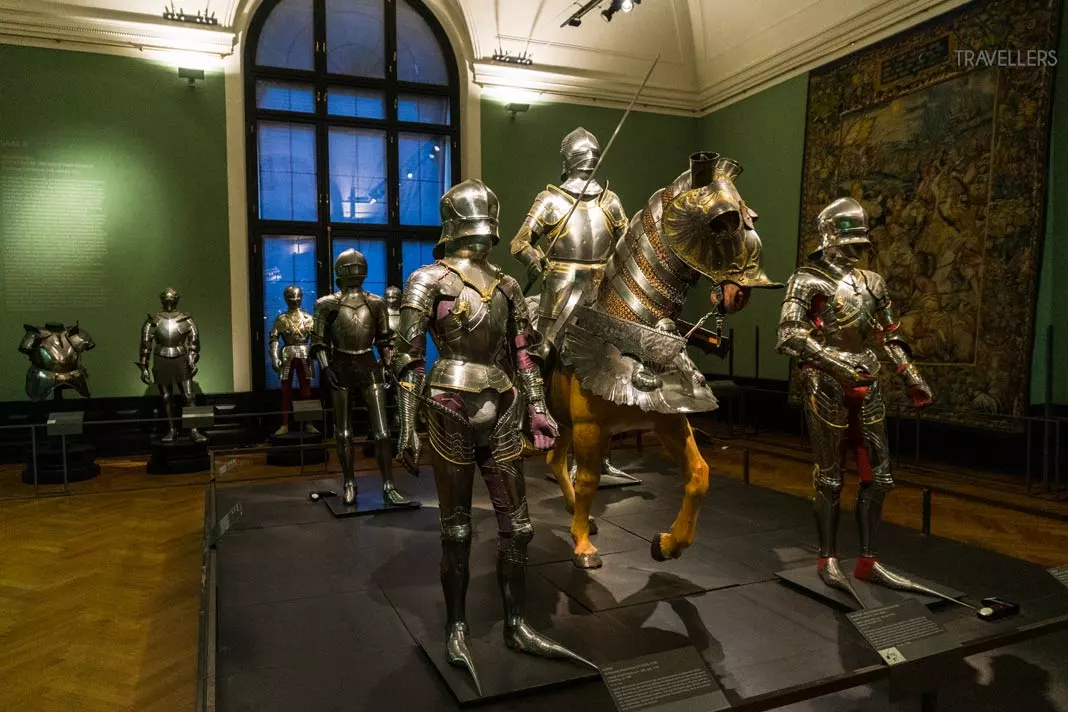
3. Ceremonial room of the Austrian National Library
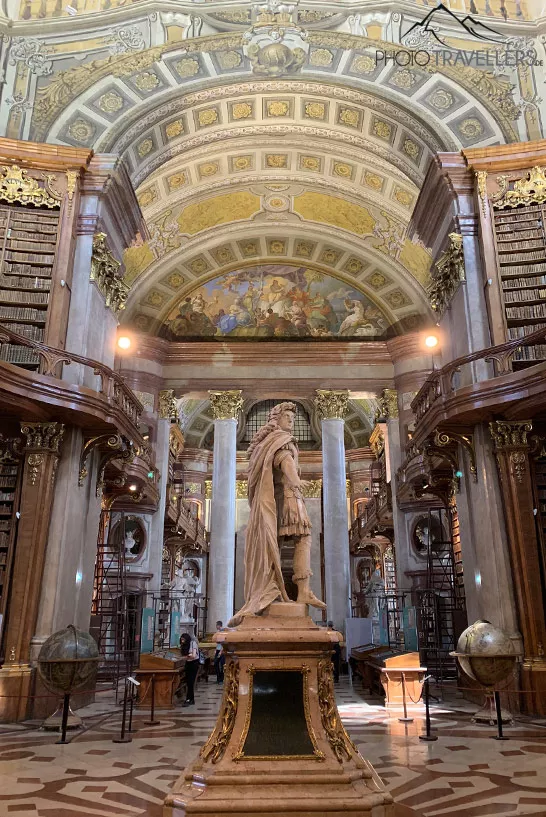
Ancient books displayed in magnificent rooms – what could be more wonderful? We are honestly absolute library fans. To see this is an awesome thing to do in Vienna!
Therefore, our visit to the State Hall of the Austrian National Library more than thrilled us. No wonder, State Hall is one of the most beautiful historic libraries in the world.
Emperor Charles VI – who lived from 1685 to 1740 – ordered its construction. The court library was built in the Baroque style. The plans for it were drawn up by the famous court architect Johann Bernhard Fischer von Erlach.
The ceiling frescoes were done by court painter Daniel Gran. For us, the National Library is a really beautiful place.
The ceremonial hall occupies the entire front of the Josefsplatz. There is also the entrance. The hall is 78 meters long and 14 meters wide. It’s almost 20 meters high.
In the center is a majestic dome flanked by two side aisles. The dome is 30 meters high. In the ceremonial hall, you can find 200,000 books from 1501 to 1850.
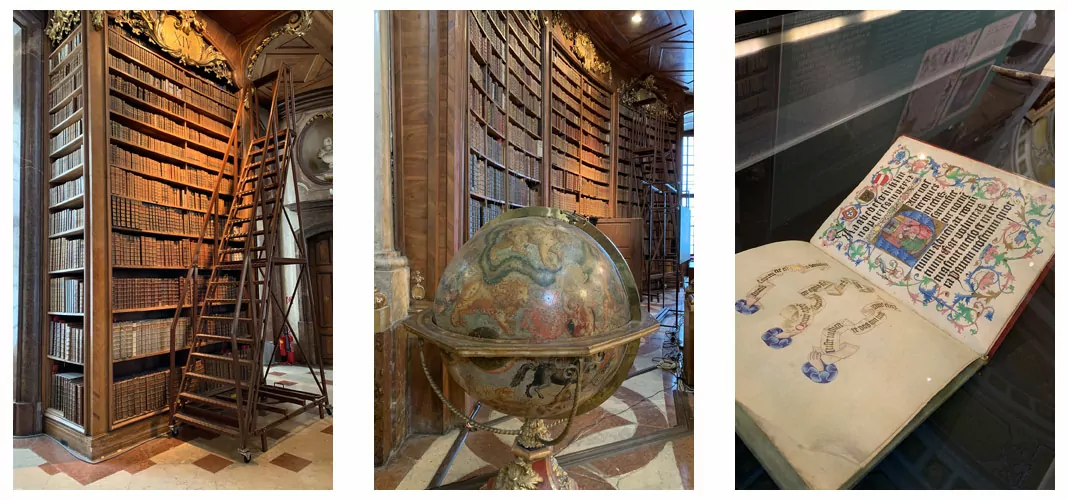
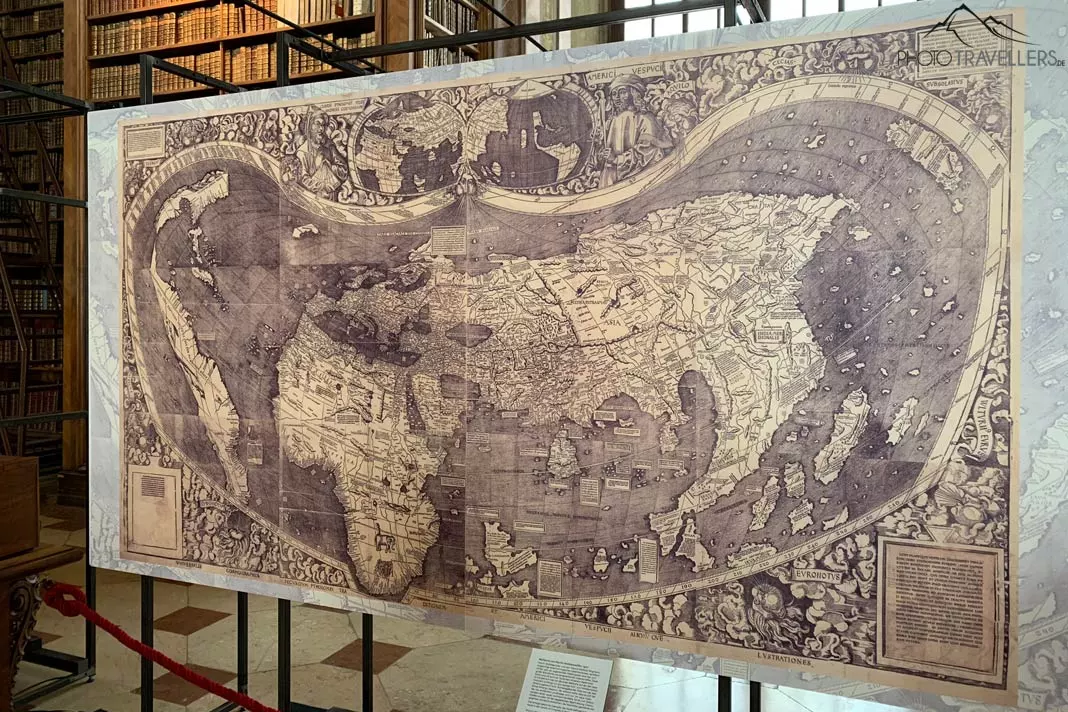
⭐ Recommended Vienna Travel Guide
Looking for a good offline guide for your Vienna trip? Then we can highly recommend some printed travel guides to you. For example if you want to spare some money and want some budget tipps on Vienna, take a look at the Super Cheap Vienna Travel Guide 2022 (get it here*). Also an all time favorite is the Rick Steves Pocket Vienna (order here*).
4. St. Stephen’s Cathedral with the catacombs
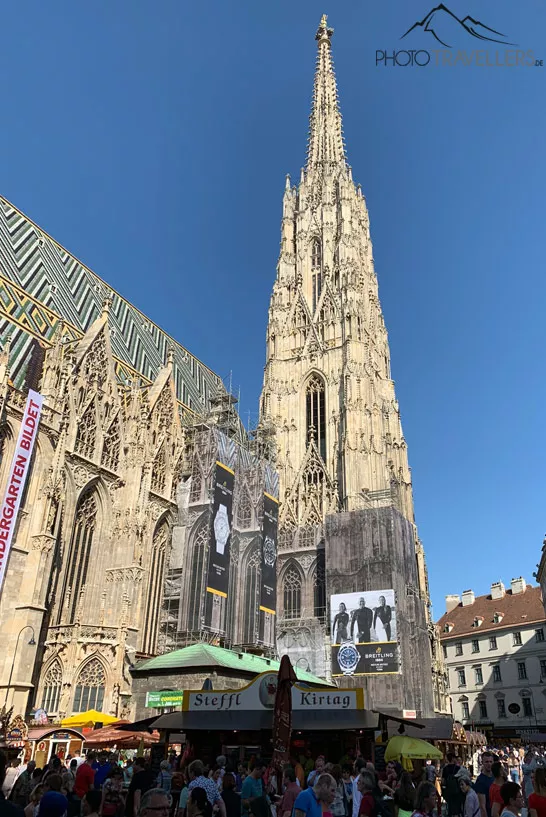
St. Stephen’s Cathedral (actually Cathedral Church of St. Stephen in Vienna) in the heart of the city is the landmark of the Danube metropolis. The south tower as the main tower rises 136 meters into the sky.
We love to stroll through the streets in Vienna. And when the colorful bricks of the cathedral appear in our view, we are enchanted every time. Vienna is such a beautiful city.
If you’re already wowed by this imposing structure from the outside, you won’t be able to stop marveling inside.
The history of the cathedral is super interesting. The first church was built here in the year 1137. The entrance is free. It’s a very fun thing to do in Vienna!
Highly recommended is the catacombs guided tour (6 euros, as of 2021). Under the cathedral are about 30 burial chambers, where the bodies of numerous Habsburgs (including Napoleon Franz Bonaparte) are buried, as well as Vienna’s cardinals and archbishops and members of the cathedral chapter.
Beneath St. Stephen’s Square lie more crypts – more than 10,000 dead were buried here in plague pits. An eerily creepy experience for young and old.
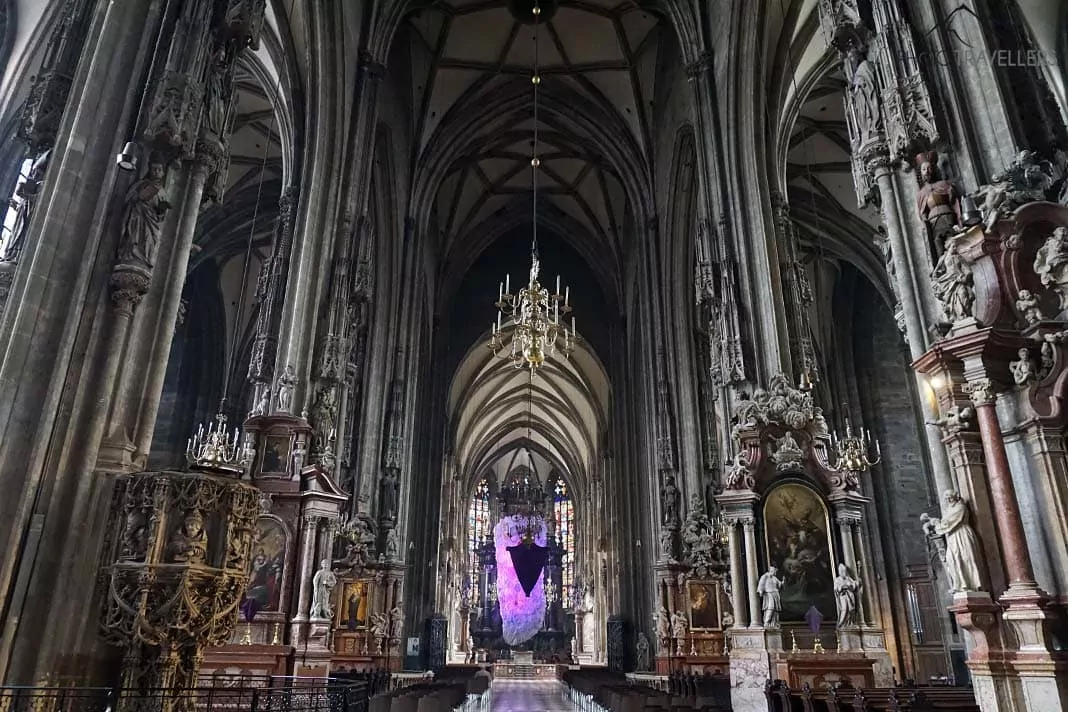
Tip: Near St. Stephen’s Cathedral is the Plague Column. It is also worth a visit- a secret place to go!
Tip: There are often great combination tickets for city tours – here you can find great tours* from time to time.
5. Capuchin Crypt
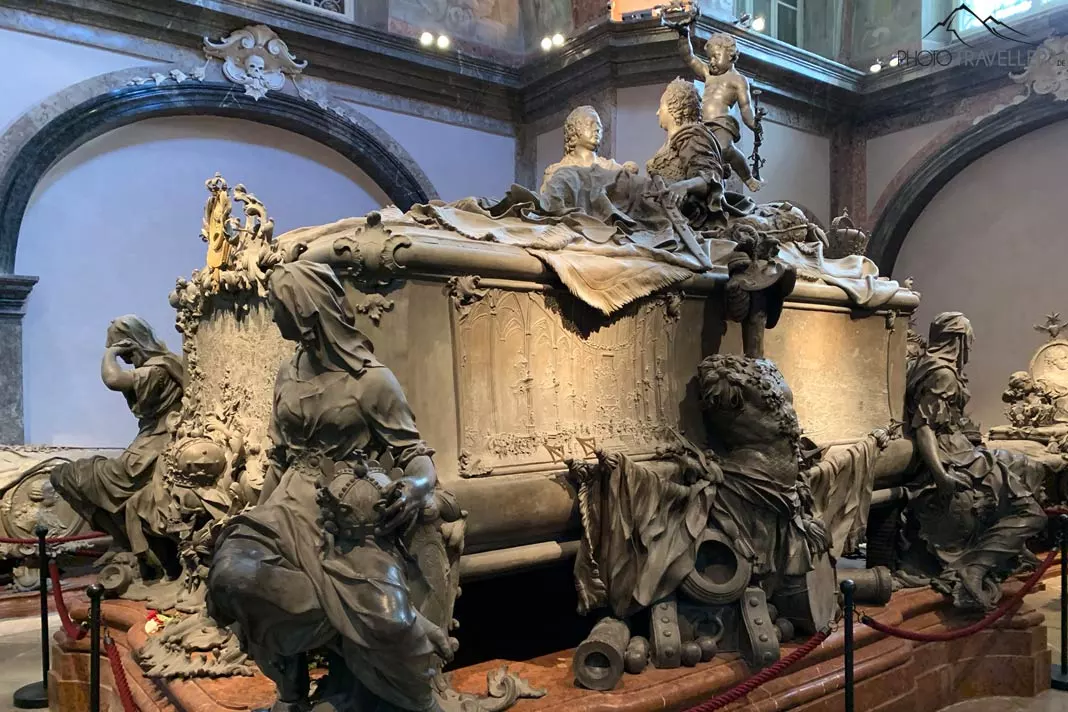
Did you know that you can visit the tomb of the famous Empress Sisi in Vienna? She is buried in the Capuchin Crypt. You can also find many other royal coffins there. It’s a very unusual thing to do!
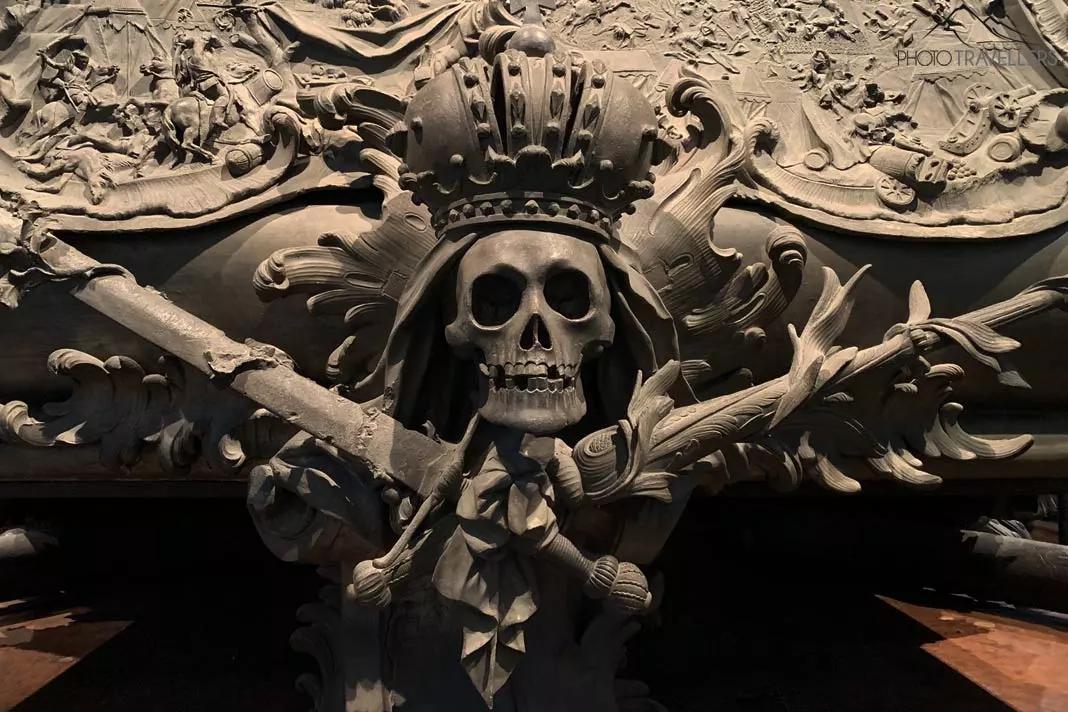
For four centuries, the mendicant order of the Capuchins has watched over the graves of the Habsburgs. 150 people lie in the Capuchin crypt today.
Empress Maria Theresa also lies down there in a magnificent coffin. She had her tomb built during her lifetime. The popular emperor Joseph II wanted a simple coffin. You can also look at it in the crypt.
Information panels tell stories about the buried Habsburgs.
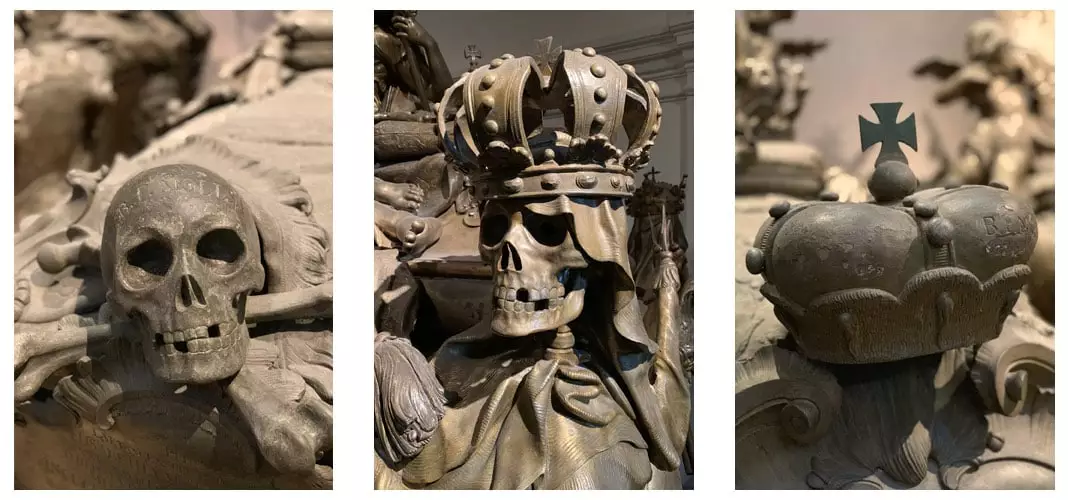
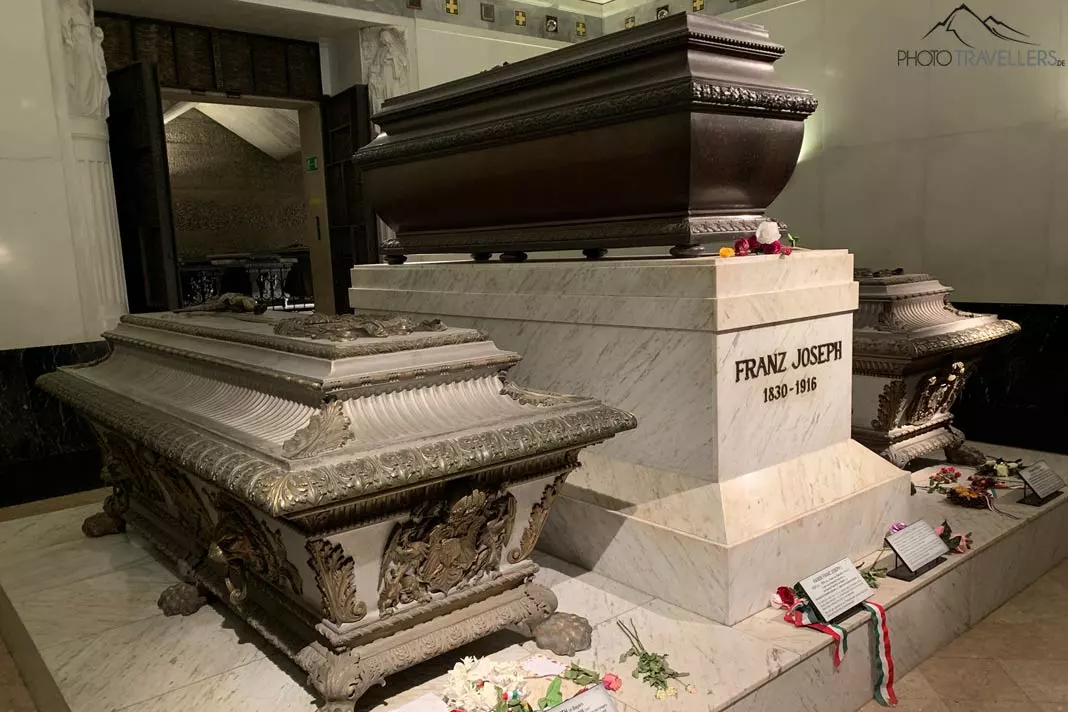
6. The Prater (Wurstelprater)
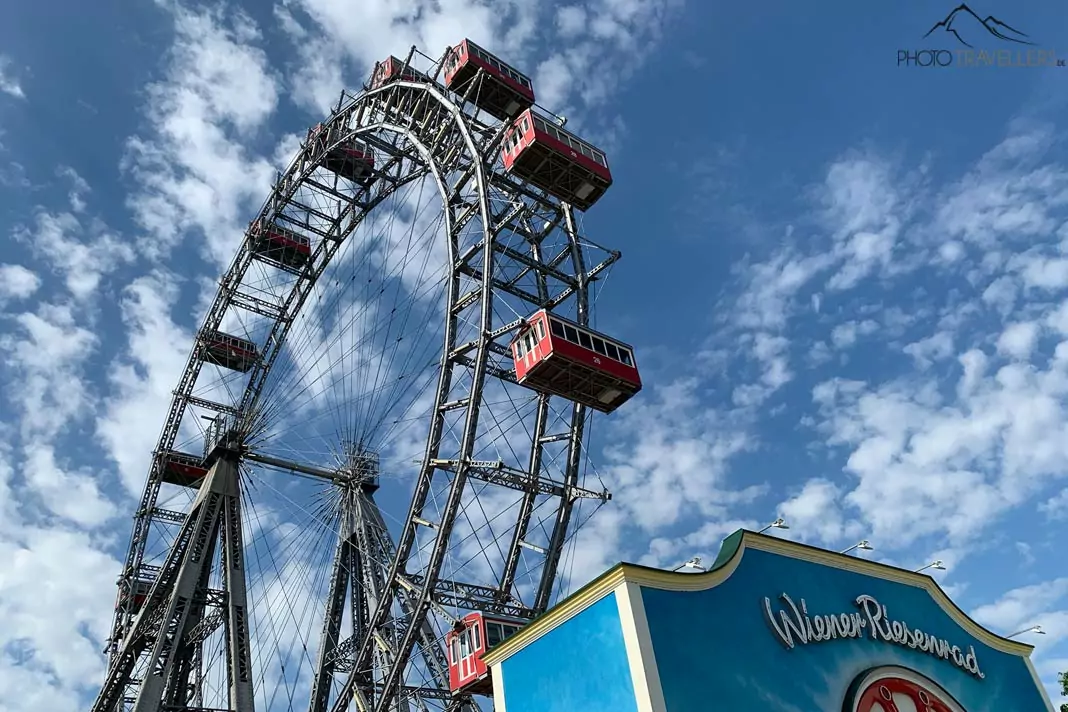
It smells of cotton candy, roasted almonds and music sounds from the loudspeakers. Now it’s clear where we are, isn’t it? Exactly, at the Vienna Prater. We’re talking about the Wurstelprater amusement park. On a six-square-kilometer meadow landscape, countless rides stand year in and year out.
One of the top things to do is the Wurstelprater with the Vienna Giant Ferris Wheel as its landmark. The Ferris wheel was built in 1897 to celebrate the 50th anniversary of the throne of Emperor Franz Joseph I. At the time, it was 65 meters high, making it one of the largest Ferris wheels in the world.
The Prater attracts around three million visitors a year and has much more to offer than just the historic Ferris wheel. Roller coasters, ghost trains, bumper cars, and countless other rides and stalls make the Prater a pleasure for the whole family. Honestly, you shouldn’t miss it.
By the way: with the Vienna Pass* you can use the Ferris wheel for free. Another tip: ride the Ferris wheel without waiting in line*.
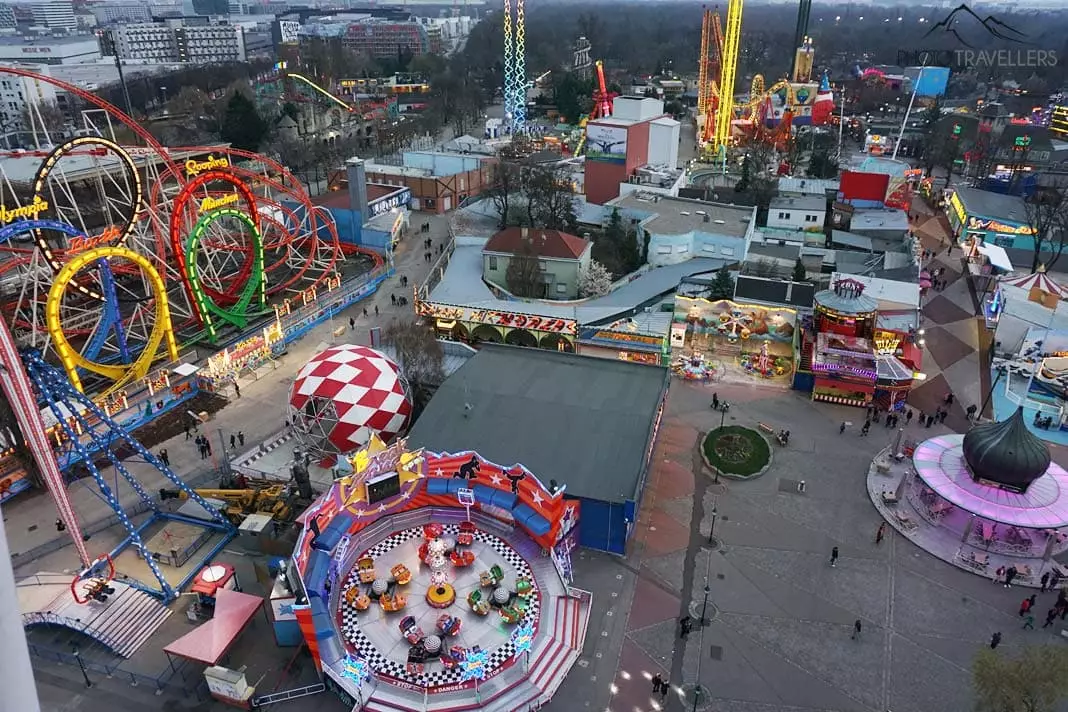
7. Vienna City Hall
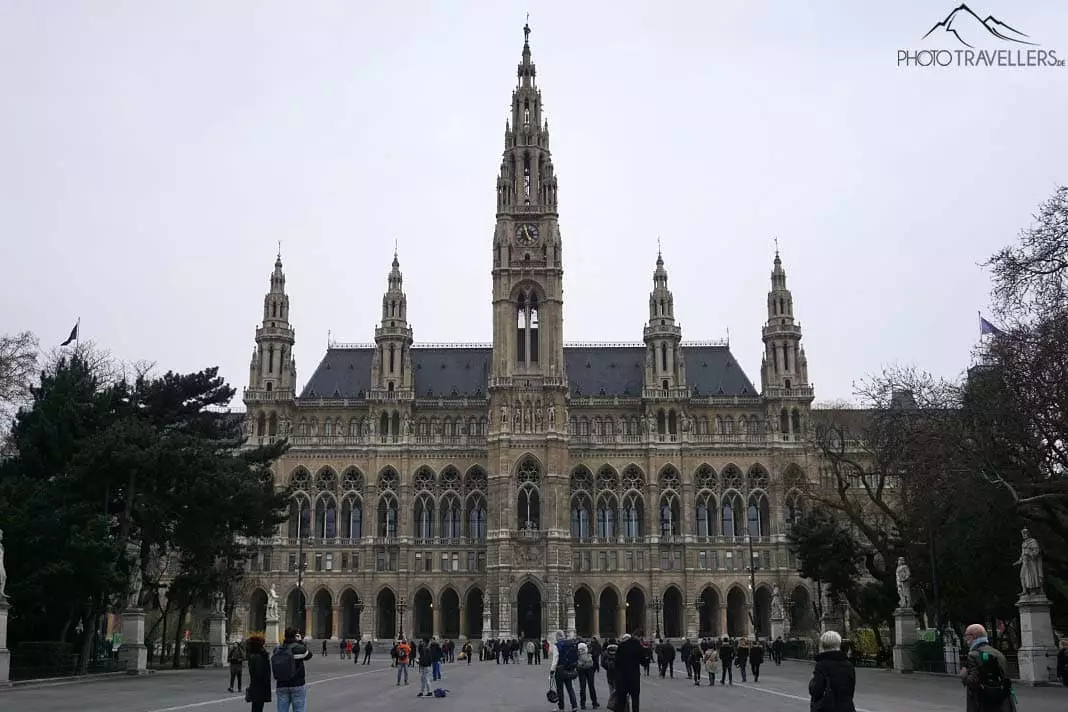
With a height of 103 meters and a neo-gothic facade, the Vienna City Hall is definitely one of the most impressive city halls in the world. Around the town hall square under the trees, countless visitors flock in the summer and enjoy the unique atmosphere.
However, the entire complex is also very beautiful. Long benches invite visitors to linger. The park is popular with locals in the summer. There is something going on everywhere. No wonder with this beautiful place. It’s one of the best places to see in Vienna!
A visit to the City Hall is an absolute must for every trip to Vienna. Due to its central location, the City Hall is easy to reach by bus and train. A guided tour of the town hall is also highly recommended.
8. Belvedere Palace
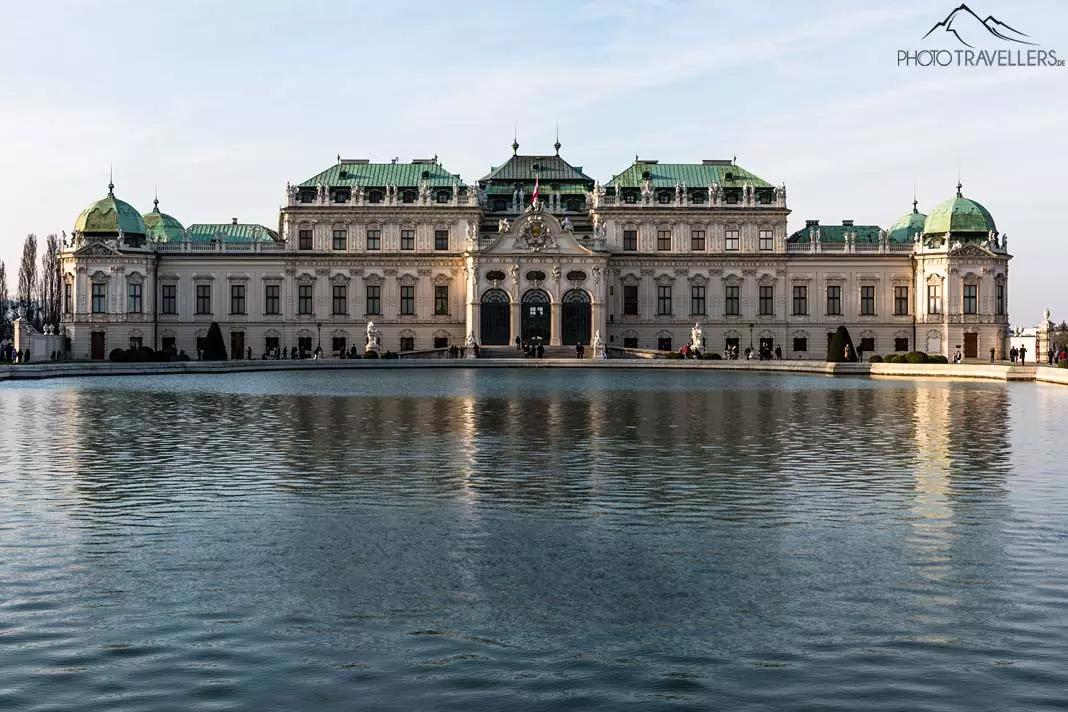
Belvedere Palace is a wonderful baroque ensemble. What’s in there to do? The rooms of the palace can be visited, and changing exhibitions are also held in the Belvedere Palace.
The beautifully landscaped palace park is freely accessible and invites you to linger with its spacious lawns, impressive fountains, and numerous park benches.
There is the Upper Belvedere and the Lower Belvedere. You should definitely drift here and enjoy the beautiful place to go in Vienna.
9. Naschmarkt
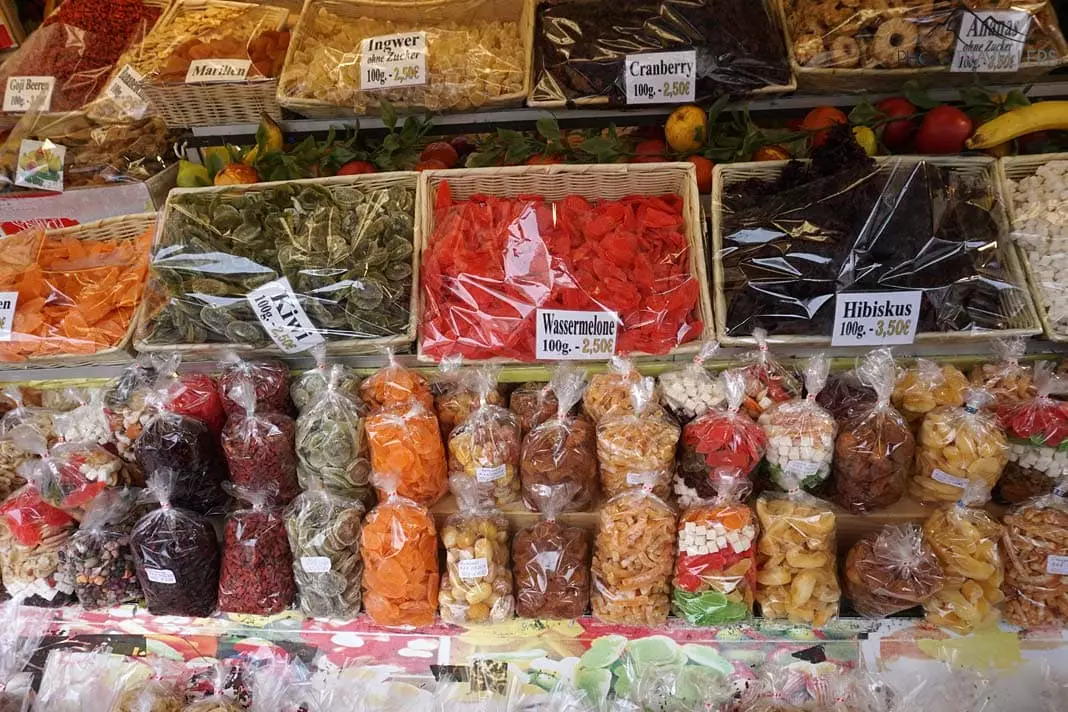
At the latest here you get big eyes. The Naschmarkt is the most famous market in the city. Around 120 stalls and restaurants spoil the visitor with a colorful culinary offer of fruit, vegetables, cheese, fish, sausage, and other delicacies from all regions of the world.
As we strolled through the Naschmarkt, we had no choice but to try one or two delicacies. This is exactly what makes the Naschmarkt so special.
It’s sure, that no one will go home empty-handed here. However, the price level is very high, after all, the Naschmarkt is now an absolute hotspot for tourists. Then you should definitely visit it.
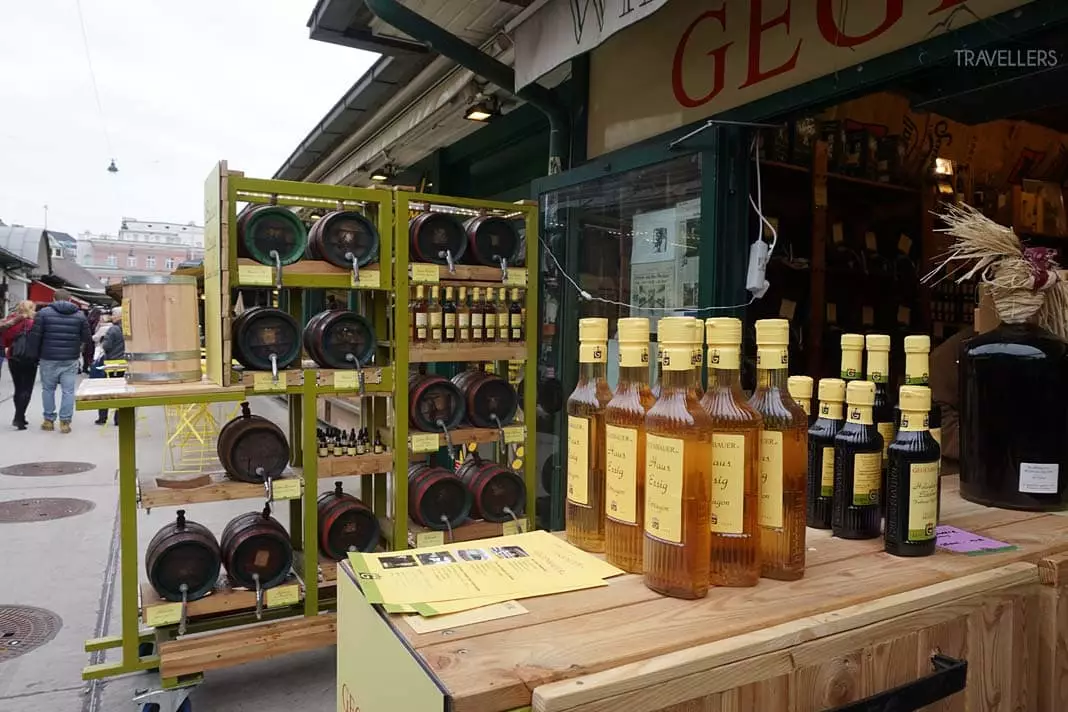
We do not advise you to make large purchases here. Unfortunately, many merchants often offer the same goods. Although the Naschmarkt has lost its glamour in recent years, a visit should still be on the agenda of every trip to Vienna.e also hearty things such as vinegar
10. Karlskirche
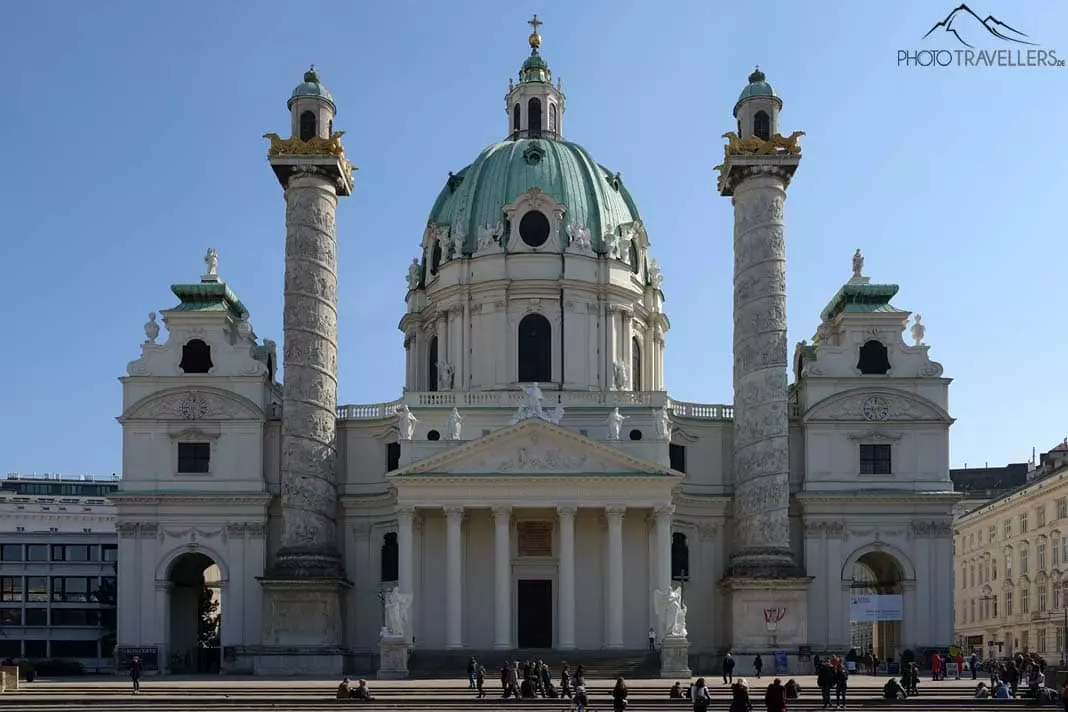
The Karlskirche – one of the city’s landmarks – immediately catches the eye because of its extraordinary architecture. Inside the Karlskirche it goes on splendidly.
A panoramic elevator takes visitors to a platform at a height of 32.5 meters. From the platform, you can view the frescoes and see the church interior from a unique perspective.
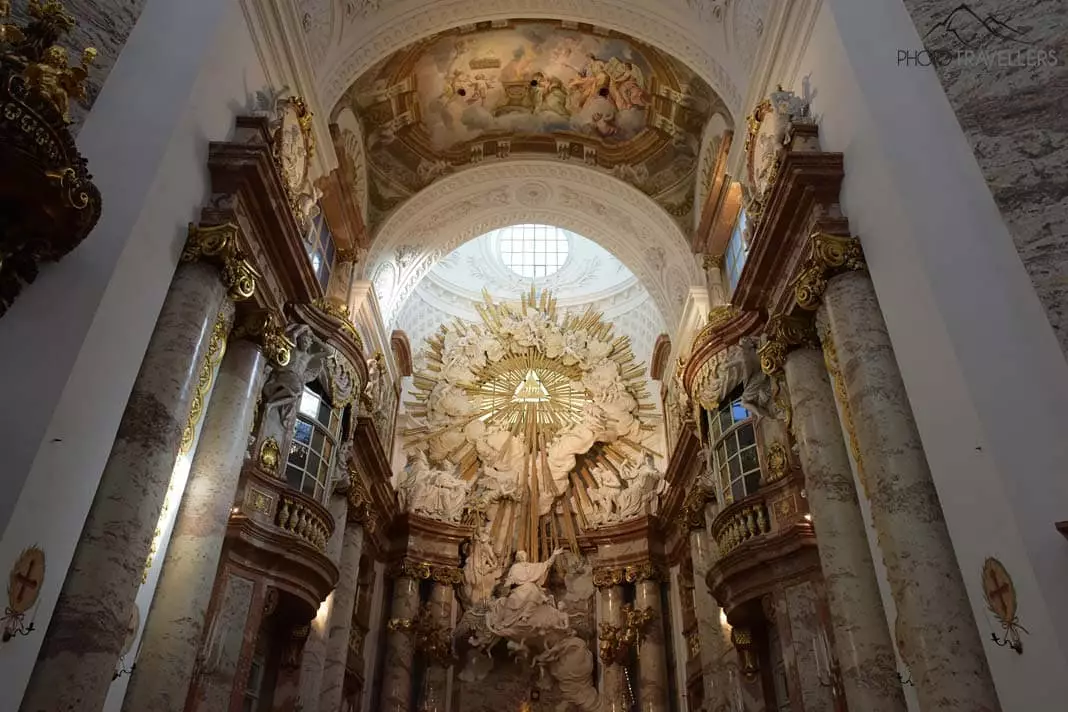
11. Hundertwasser House
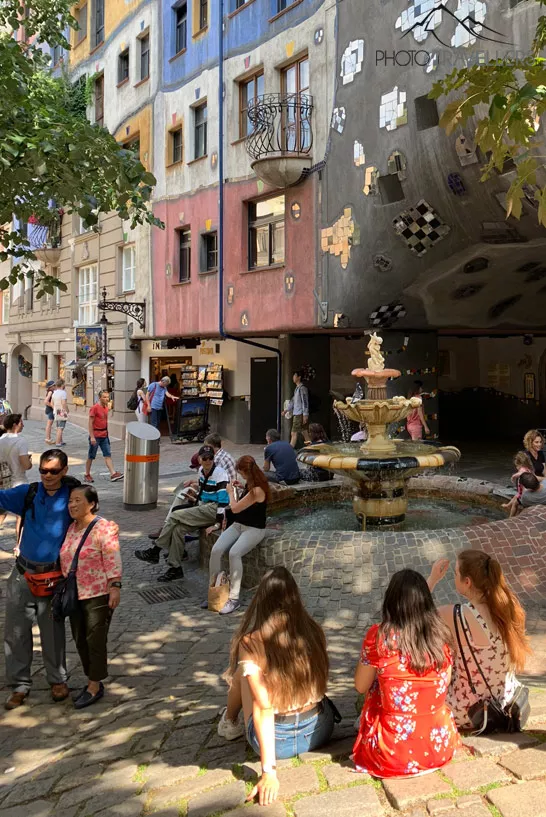
The Hundertwasserhaus is also one of the best things to see in the city. It is definitely a visitor magnet. Already in the immediate vicinity, small stores sell souvenirs and all sorts of odds and ends.
When you stand in front of the building, you have to put your head in the back of your neck to make sure you can see everything. The house holds some interesting corners and beautiful places.
The Hundertwasser House was once designed by architect Josef Krawina and created by painter Friedensreich Hundertwasser. With its colorful facade, it catches the eye and is a beautiful thing to see in Vienna.
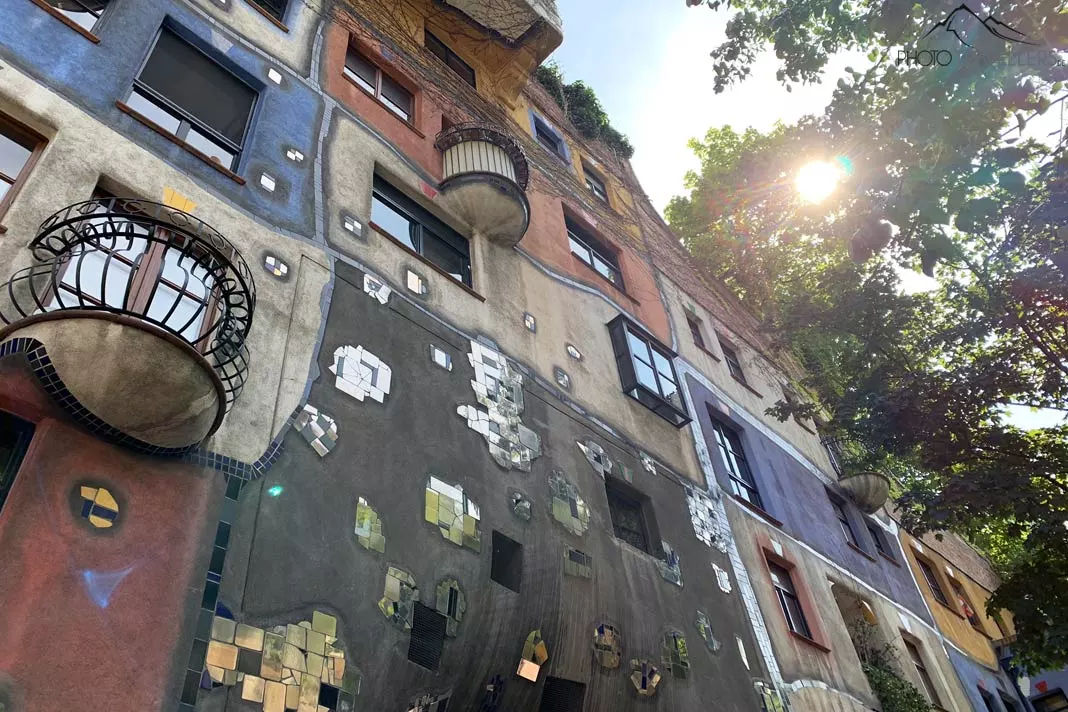
However, the facade has not been as colorful as it appears on many posters and postcards for a long time. In front of the building, there are numerous tourists, who probably get on the nerves of the building’s residents.
Access to the building is therefore understandably prohibited. Unfortunately, you don’t have a very good view of the Hundertwasser House from the street – nevertheless, you should have seen it once.
A small store on the first floor with souvenirs also invites you to do a little shopping.
Tip: Opposite the Hundertwasser House is the Hundertwasser Village – a small shopping mall with souvenirs. This is also designed in the Hundertwasser style.
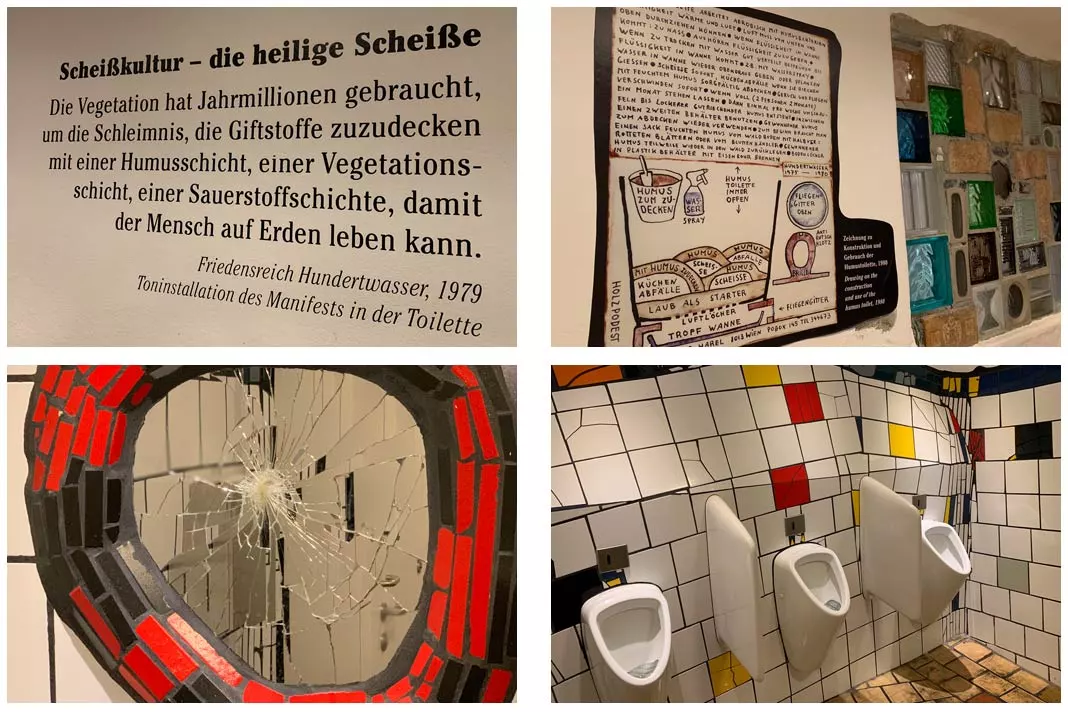
Very popular is the toilet in the basement. It costs 80 cents and is designed in the colorful style of the Austrian artist. In addition, a shit monologue runs in the restroom, which is very funny. So, it is worth to pay a visit to the toilet
12. Kärtner Street with the Hotel Sacher & Sacher Torte
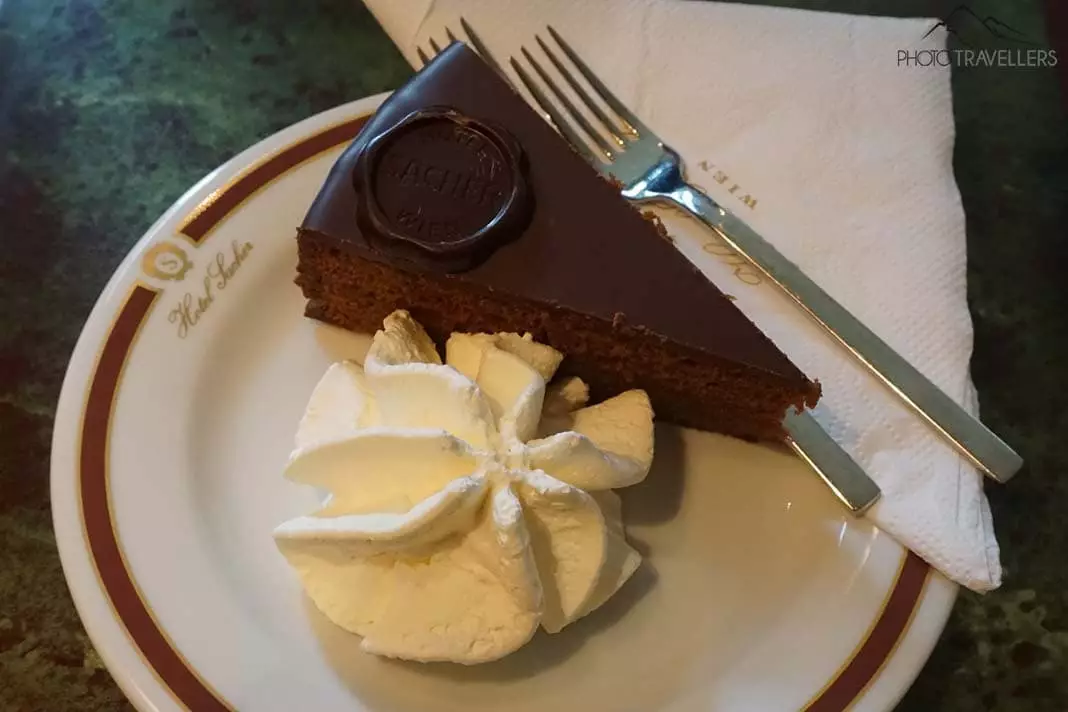
Part of any visit to Vienna is to try a Sacher Torte at least once. Where better to do that than at the Hotel Sacher in the Sacher Café on Kärtner Straße? The Sacher Torte has existed in its current form since 1832 and is certainly the most famous cake in the world. It’s a very cool thing to do in Vienna!
Chocolate cake, apricot jam, and a noble chocolate coating make the cake what it is. A treat for the mouth, which unfortunately is not quite cheap. But hey, how often are you in Vienna?
Tip: At the end of Kärntner Straße, right next to St. Stephen’s Cathedral, you’ll find “Der Stock im Eisen” on the corner. What you see there behind a glass case is a Zwieselfichte from the Middle Ages.
Numerous nails were hammered into it. That’s why this species is also called a nail tree. The Viennese stick-in-iron is the oldest surviving nail tree. It was first mentioned in a document in 1533.
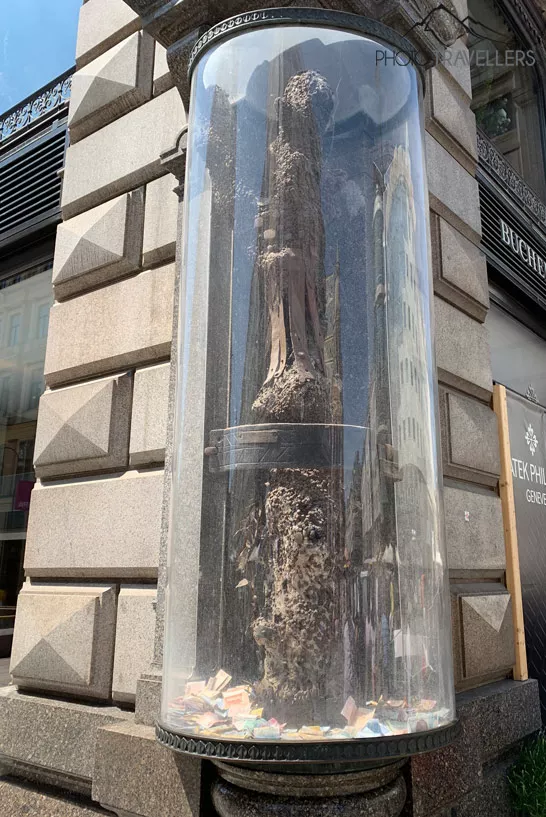
Also, in the Kärnterstraße you can find really great, rustic stores. Therefore, it is worth a ramble and a stroll. The pastry shop Sluka, for example, has been around since 1891.
Café Aida has been located at St. Stephen’s Cathedral since 1913. But the Lobmayr store, which has been around since 1823, is also worth a detour. You will also have to pass the Maltese Church. It has been here since 1806.
13. Parliament
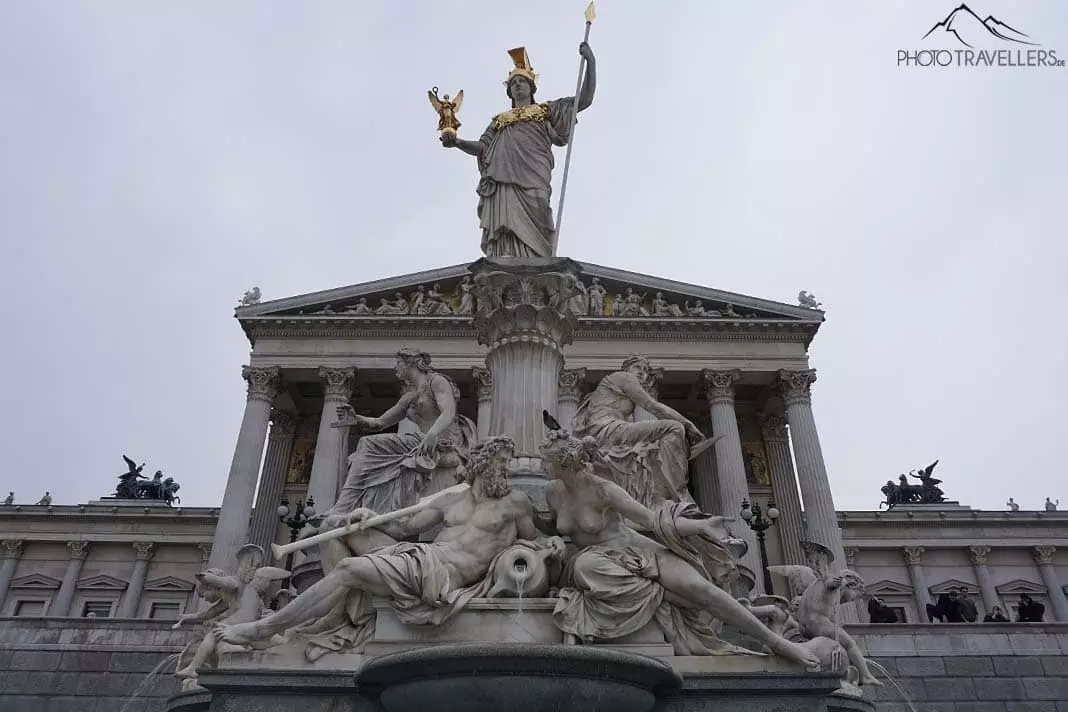
The two chambers of the Austrian parliament meet in the parliament building on Vienna’s Ringstrasse. Built from 1874 to 1883 in neoclassical style, the building is a popular destination for many tourists.
A highlight is the Pallas Athena Fountain in front of the parliament building. There are also eight statues carved out of marble to admire. Visitors can also take a tour of the building or attend a session.
The huge square is beautifully designed and definitely worth seeing. You can tell we’re in love with every sight in Vienna.
14. Votivkirche
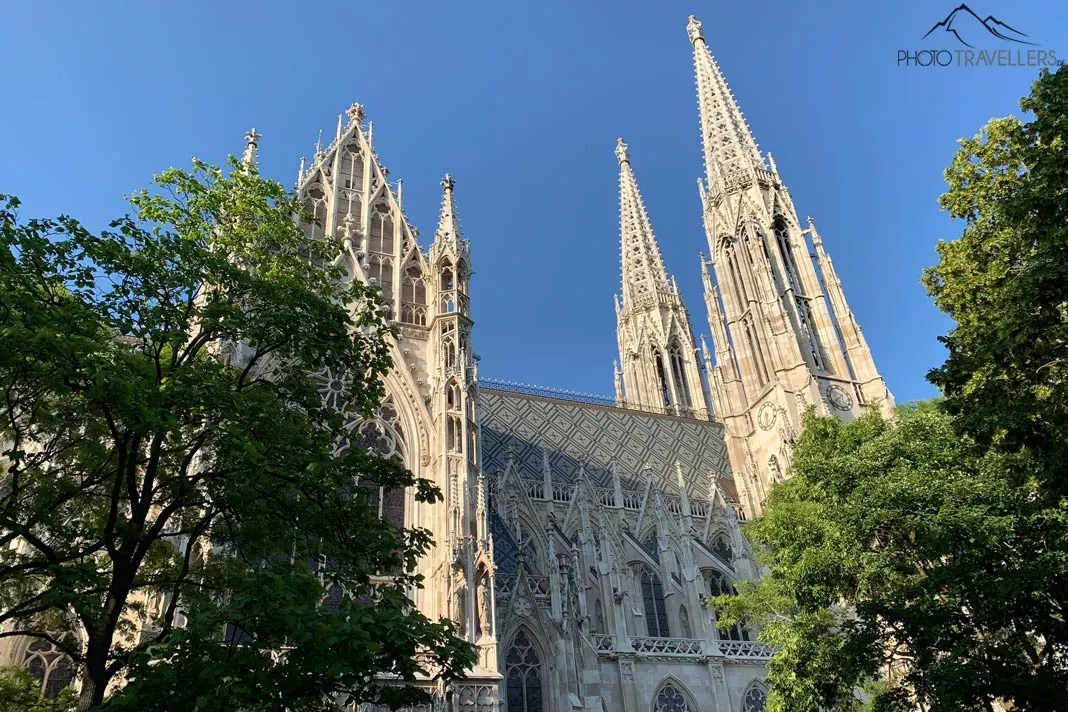
Of course, the Votivkirche is also one of the most popular sights – and by the way, the church is one of the most important neo-Gothic sacred buildings in the world.
At 99 meters, the Votivkirche is the second highest church in Vienna. Even from afar, the impressive church towers stand out. Absolutely worth seeing is the interior of the church with the impressive high altar and the numerous chapels.
However, you have to walk a bit to get to the Votivkirche. But in our opinion, the walk is worth it. What do you think? However, Vienna also has a great public transportation network. The metro stop is Schottentor.
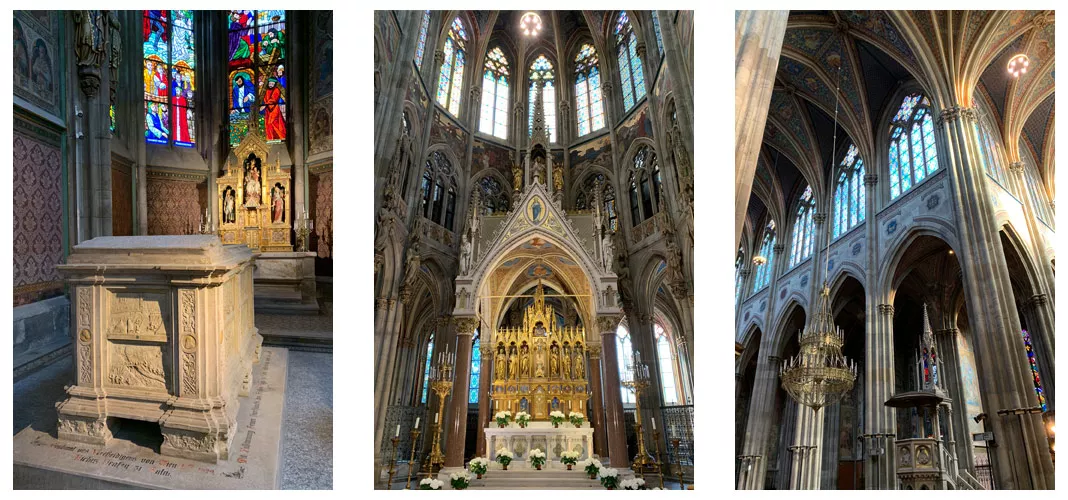
15. Volksgarten
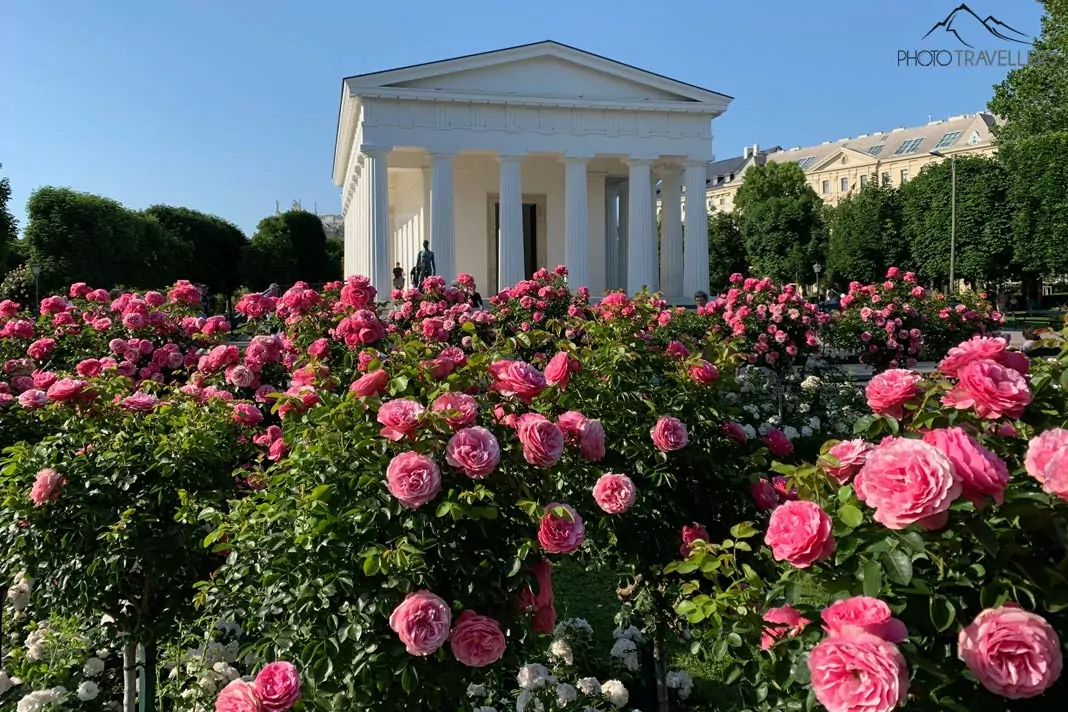
I love it when the roses bloom in summer and it smells so wonderful. If you want to see a true splendor of colorful flowers, then you have to go to the Volksgarten. It is a small oasis of peace and a wonderful place.
The generously designed park with the white Theseus Temple in the middle of the beautifully designed park landscape and the rose garden belongs to the green lungs of Vienna. In summer, it is great to spend time here on one of the many shady park benches.
Since 2001, the Volksgarten with the historic center has been a UNESCO World Heritage Site. When the roses bloom in June, the Volksgarten is very busy.
Our tip: Go there in the morning. When the morning dew is on the roses, everything is quiet and calm, then you can take dreamlike pictures here.
16. Natural History Museum
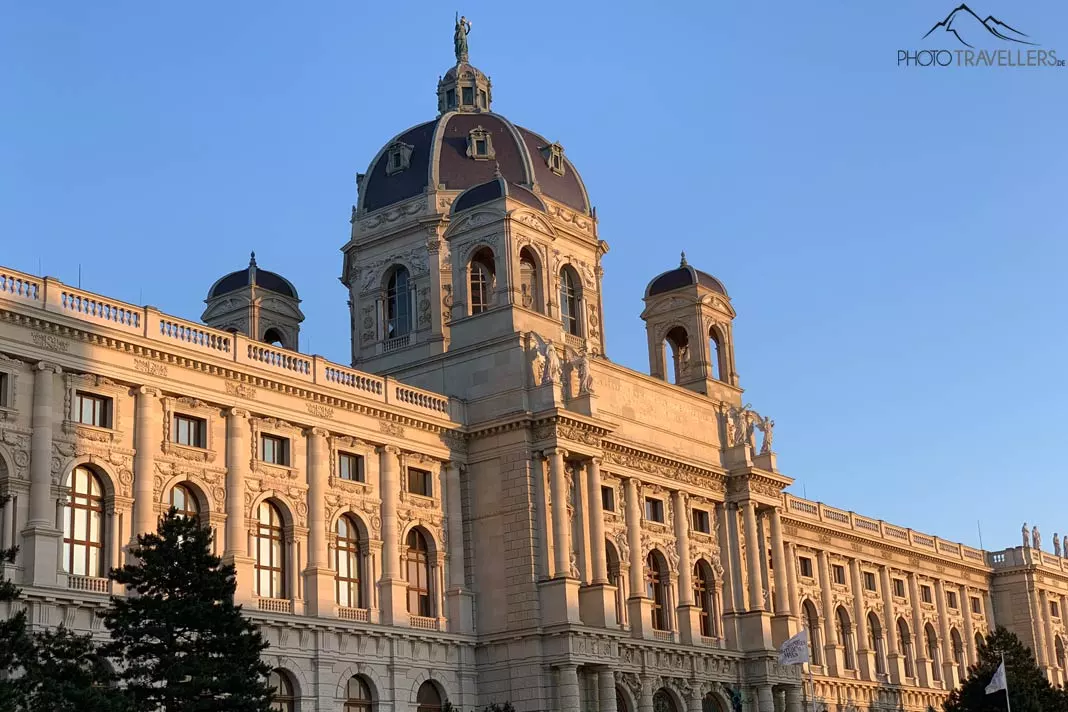
The Natural History Museum is one of the most important nature museums in the world and one of the largest museums in Austria. Especially when the weather is bad, a visit to the Natural History Museum is a good idea.
What’s to see in the museum? Already the facade impresses. In the exhibition rooms, there are all kinds of things to discover, from dinosaur skeletons to minerals and prehistoric artifacts. On a rainy day, the museum is definitely the perfect place for an interesting and entertaining afternoon.
17. Museum Quarter Vienna
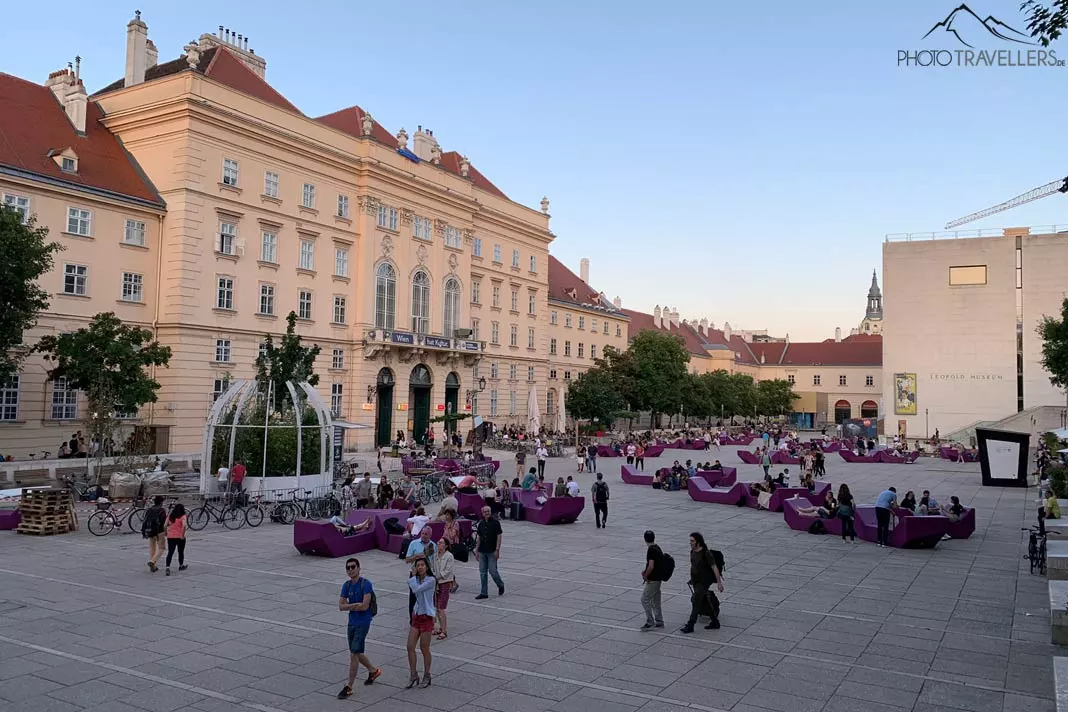
Art-loving visitors will find what they are looking for in the Museumsquartier Wien. In the huge area, you can find for example the Kunsthalle Wien for international contemporary art, the mumok for modern art, or the Leopold Museum with works of Viennese Modernism and Austrian Expressionism.
The inner courtyard is always quite crowded in the summer evenings. We love the flair of the Museumsquartier. In the evening, the courtyard turns into a big chillout zone. There are several bars and cafes.
18. Art House Vienna
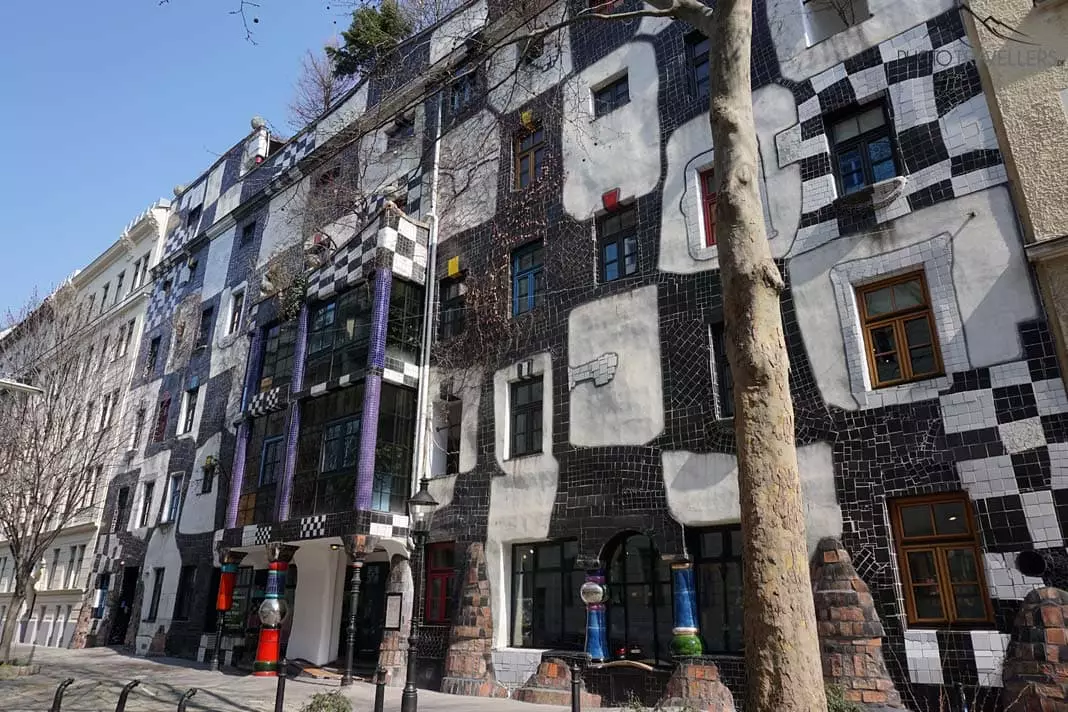
Kunst Haus Wien is located in close proximity to the Hundertwasserhaus. The Kunst Haus Wien houses a museum with works by Friedensreich Hundertwasser.
In addition, temporary exhibitions of works by other artists are shown regularly. Especially the eye-catching Hundertwasser facade attracts many photo tourists. No wonder, it is designed very elaborately.
19. Central Cemetery

Right from the start: the Vienna Central Cemetery is simply huge. Personalities such as the music icon Falco lie there, as well as other famous people such as Ludwig van Beethoven, Brahms, Johann Strauss, and other honorary citizens of the city.
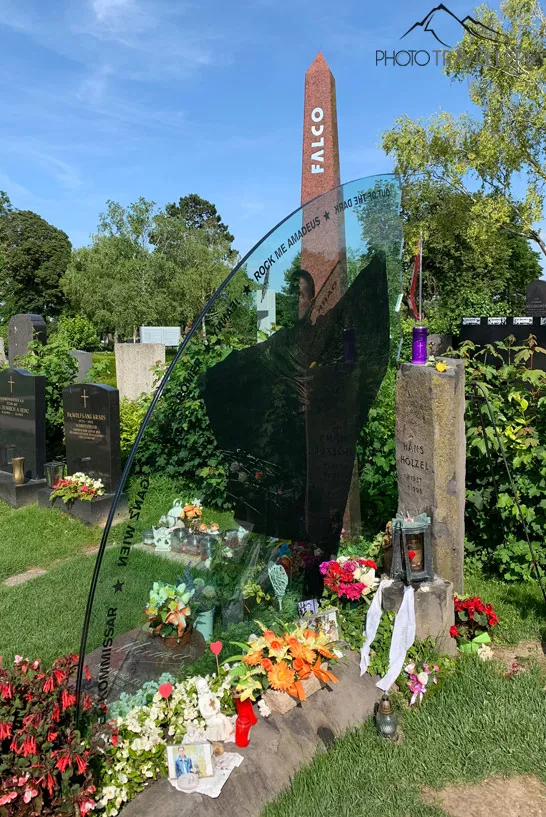
We advise you to take the public transport to Gate 3 and then walk to the area of the honorary graves. There you will quickly notice the distinctive grave of Falco. A huge glass sculpture with a print of his photo adorns the grave.
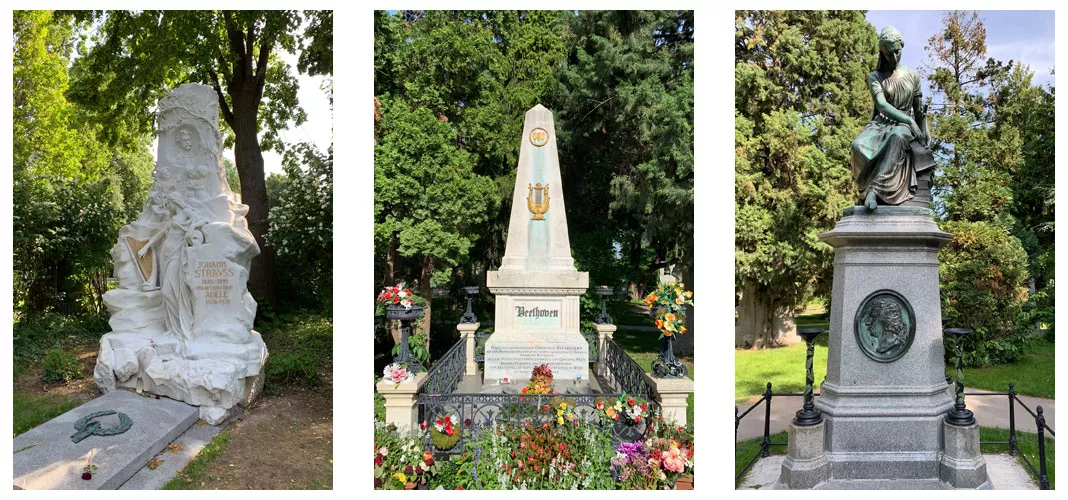
From the honorary graves, you now walk parallel to the entrance and arrive at the Catholic Dr. Karl Lueger Memorial Church. It looks very imposing from the outside. It is also worth taking a look inside. The round room is designed with a huge dome. The interior is blue – like the sky.
From the church, keep going in the direction of the exit. On the right side, you will have passed the graves of famous composers like Ludwig van Beethoven, Brahms, Johann Strauss, and Franz Schubert. Shortly before the exit to Gate 2, it is worthwhile to turn back to the right in the direction of Gate 3. On the way, you will have to pass many specially designed graves.
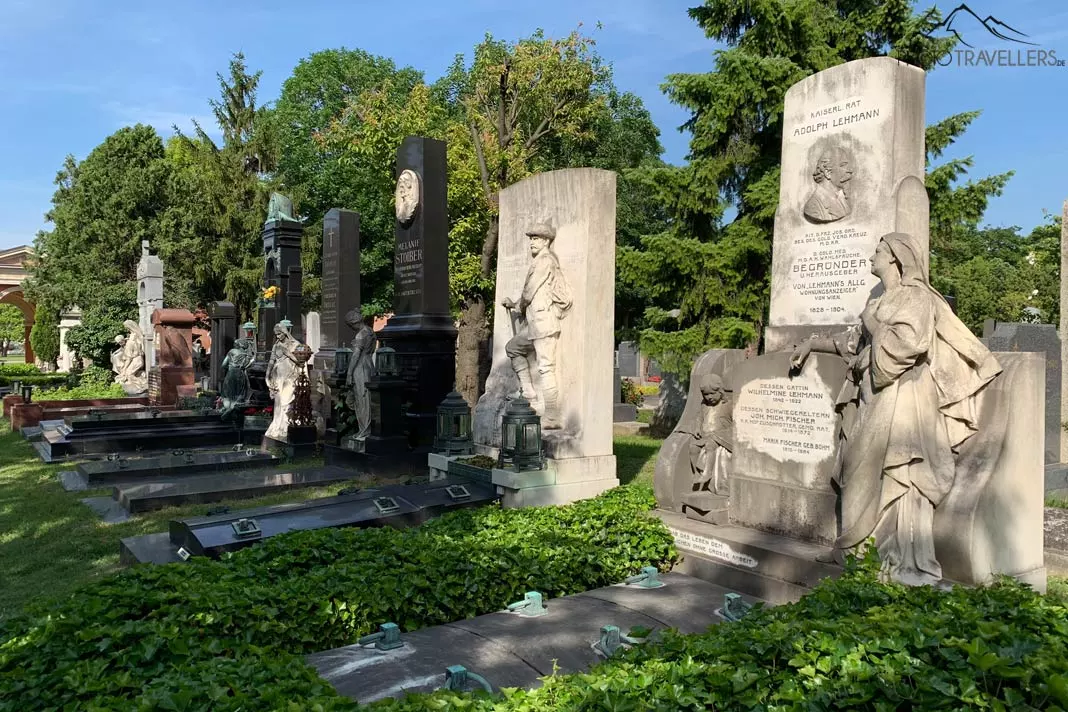
20. Albertina
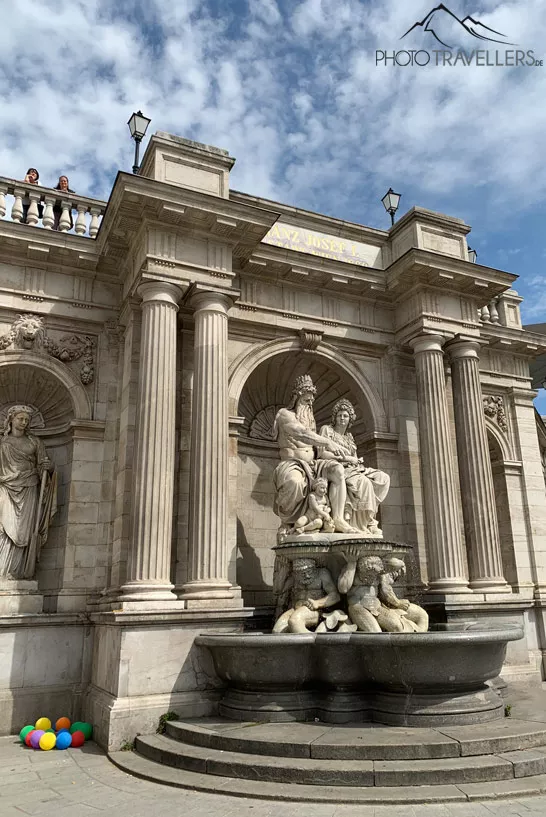
The Albertina is an art museum in Vienna. There you will find one of the most important graphic collections in the world. The collection is in the Palais Erzherzog Albrecht.
This is a historical residence of the Habsburgs. The art museum got its name from its founder Albert Casimir Duke of Saxe-Teschen. He was the son-in-law of Empress Maria Theresa.
The collection includes one million drawings and prints. These works of art range from the Renaissance to the present.
Today, the Albertina also features the Batliner private collection. There is a show on classical modernism entitled “Monet to Picasso. The Batliner Collection.”
If drawings don’t interest you, then a visit to the Albertina is still worthwhile. You can, in fact, look at the rooms of the Habsburgs. From the Rococo Room to the Wedgwood Cabinet, to the Fireplace Room or Reception Hall, everything looks very splendid.
The entrance fee is 16 euros.
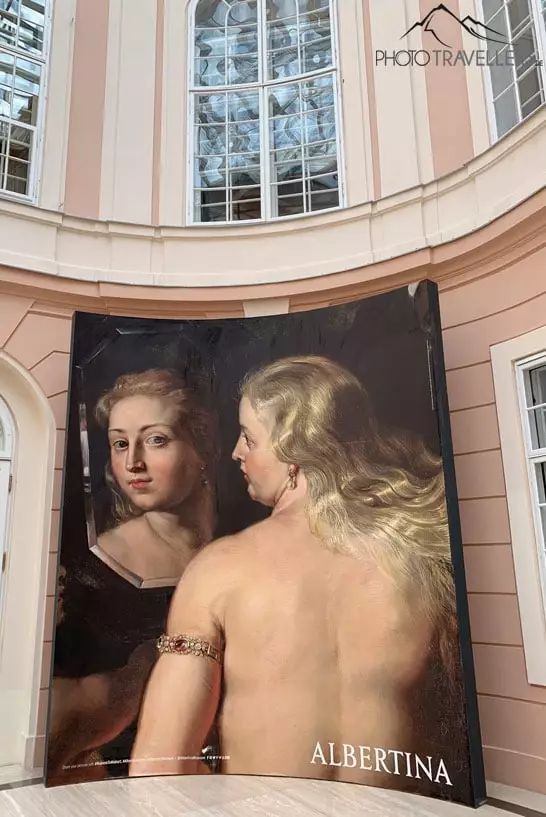
21. Monument to Mozart in the Burggarten with Butterfly House
From the terrace of the Albertina, you have a beautiful view of the Burggarten. There in the Burggarten is the Mozart monument. In summer, the meadows are also occupied by the Viennese and tourists for picnics or to rest. The figure of Mozart is made of marble from Lasa.
Mozart spent ten years in Vienna from 1781 as a freelance composer. Works such as the Magic Flute was written here in Vienna. In the last year, he lived in the Small Kayser House. It was located at the back of today’s Kaufhaus Steffl at Kärntner Straße 19. Today there is a memorial plaque there. Mozart died on December 5, 1791, and was buried in a common grave at the Sankt Marx Cemetery. There is only a memorial at the Central Cemetery.
Also, worth a visit is the Butterfly House. The entrance fee is 7 euros.
22. Anchor Clock
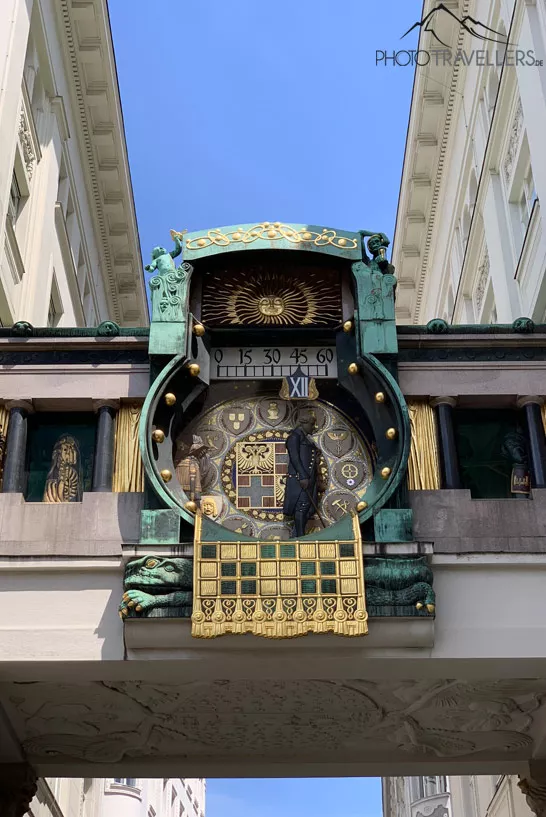
On one of the oldest squares in Vienna is the famous Ankeruhr. In former times the command building (Praetorium) of the Römerlager Vindobona was located here. The Anker Clock dates back to the Allgemeine Versicherungs-Aktiengesellschaft Der Anker (an insurance company), which was founded in 1858.
This insurance company had the Ankerhof built from 1912-1914 and artists erected the Anker Clock. According to the inscription, it is dedicated to the people of Vienna.
The clock has a total of 12 figures. Exactly at 12 o’clock, these figures move once in the clock. The spectacle lasts 12 minutes.
It reminded us very much of the Glockenspiel at Munich’s Marienplatz. The figures show Emperor Charlemagne, Empress Maria Theresa, and many other famous nobles.
23. Oldest church in Vienna – Ruprechtskirche
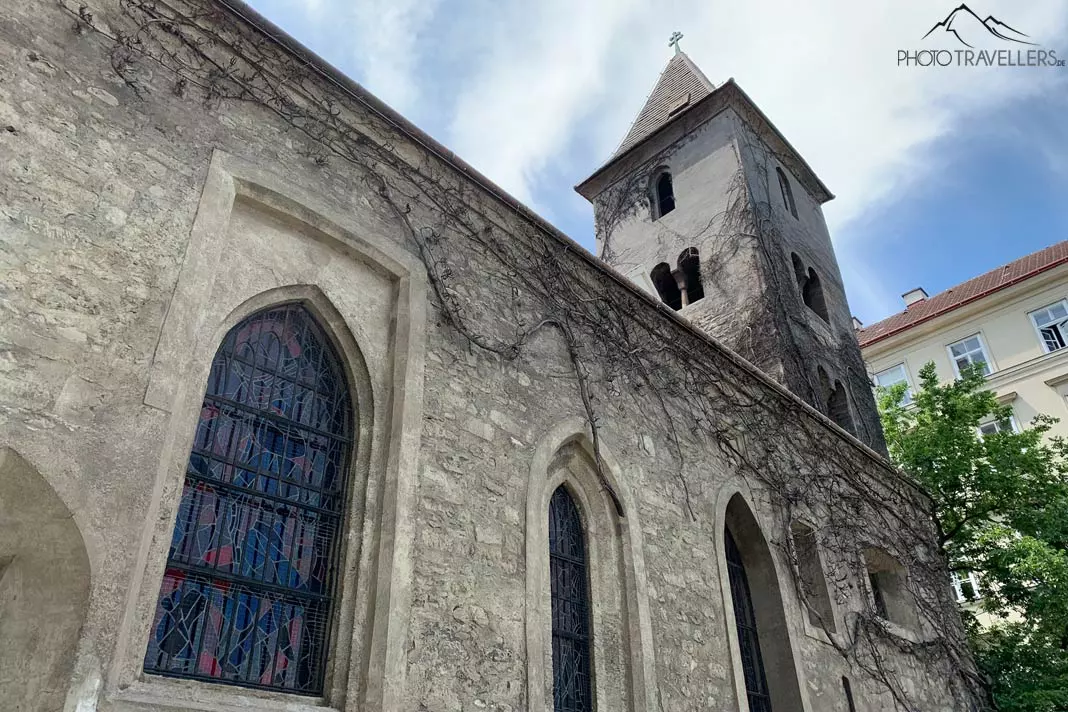
The oldest church in Vienna is the Ruprechtskirche on the Ruprechtsplatz. The nave as well as the lower tower floors date back to the 11th century.
Its patron saint is Saint Ruprecht, the patron saint of salt boatmen. The church was first mentioned in a document in 1200, but according to legend, it was founded around 740.
The church is located near Jewish Lane. It was from here that Adalbert Stifter observed the only total solar eclipse to occur in modern Vienna on July 8, 1842. A sign on the wall of the house commemorates this spectacular observation.
There is a lot going on here in the evening. The pubs around the church attract many visitors. For Tatort fans (a german series with the name “crime scene”), there is a Tatort evening on Sunday at the Bar Philosoph.
24. Danube Island
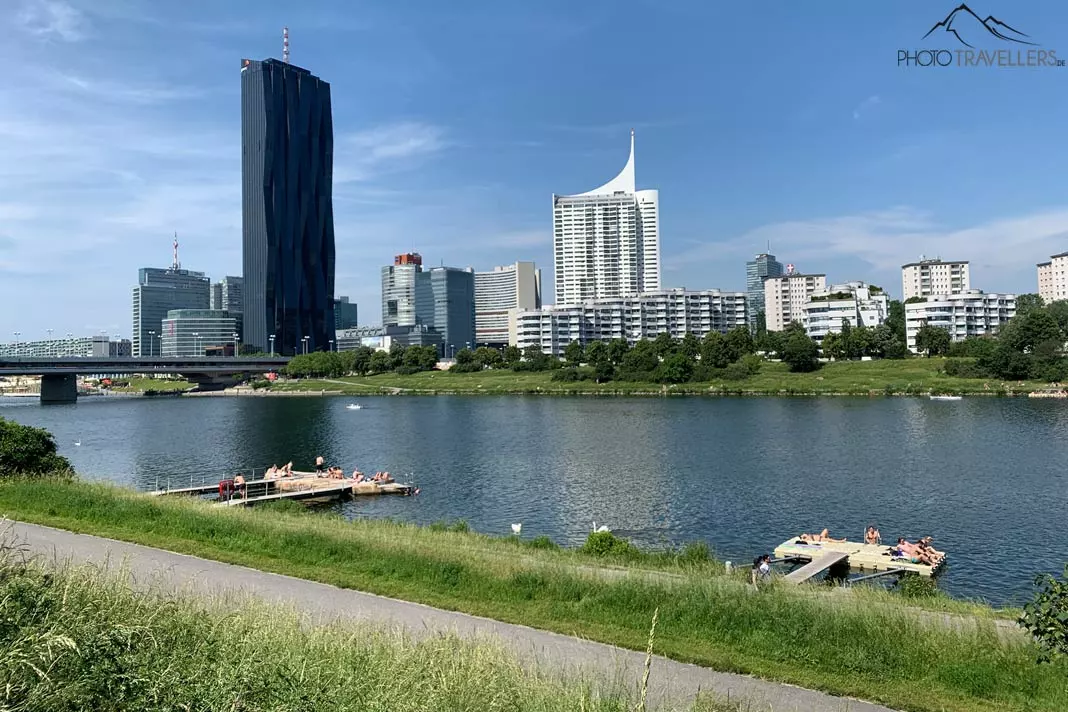
Grab a modern e-scooter and ride it to Danube Island. Vienna’s green lungs await you here. Because when the hustle and bustle become too much for the city dwellers, they flee to Danube Island.
The area was built between 1972 and 1988 and separates the Danube from the New Danube. Danube Island is part of Vienna’s flood protection system and is also a popular recreation area.
If you just want to relax and enjoy the sun or fire up the grill, this is the place to be. A highlight for children is the world’s largest floating trampoline facility.
Our insider tips for your Vienna city trip
Secret tip 1: Creepy cellar tour
By the way, the city is sifted like Swiss cheese. If you want to dive into Vienna’s underworld, turn with confidence to Peter, who will take the visitor into the darkness. There are old cellar vaults to see, and Peter has plenty of entertaining and creepy stories to tell about them. If you’re looking for a different kind of sightseeing program, this is the place for you.
Useful information: Cellar tour with Peter*.
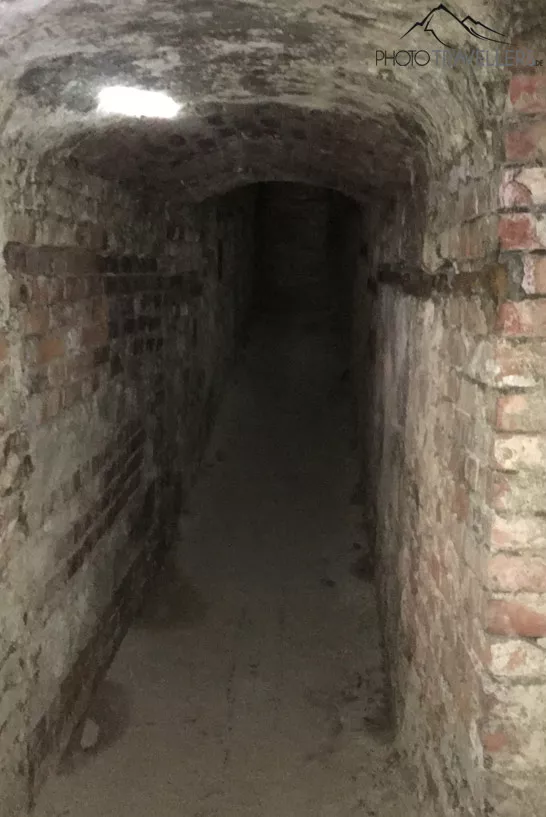
Insider tip 2: Spittelau waste incineration plant
If you are traveling in Vienna, you will often see this huge tower with the golden sphere in the distance. The tower belongs to the waste incineration plant Spittelau, whose facade was artistically designed by Friedensreich Hundertwasser. A detour is definitely worthwhile. Also, because the Spittelau waste incineration plant, built from 1969 to 1971 and rebuilt after a major fire in 1987, attracts far fewer tourists than other sights.
Useful information: Spittelau waste incineration plant
Insider tip 3: Kreuzenstein Castle
Kreuzenstein Castle is located a few kilometers north of Vienna and was a medieval castle complex. However, the old fortification is no longer preserved.
It was replaced by a show castle, which was built between 1874 and 1906. All kippers and curtains? If you don’t know that Kreuzenstein Castle is not a real knight’s castle, you will never guess.
The castle complex, in which at least a few remnants of the original castle have been built, is really well designed. Apparently, many filmmakers also like the castle – Kreuzenstein Castle has been the backdrop for numerous film productions. The beer garden at the entrance of the castle is also worth a visit.
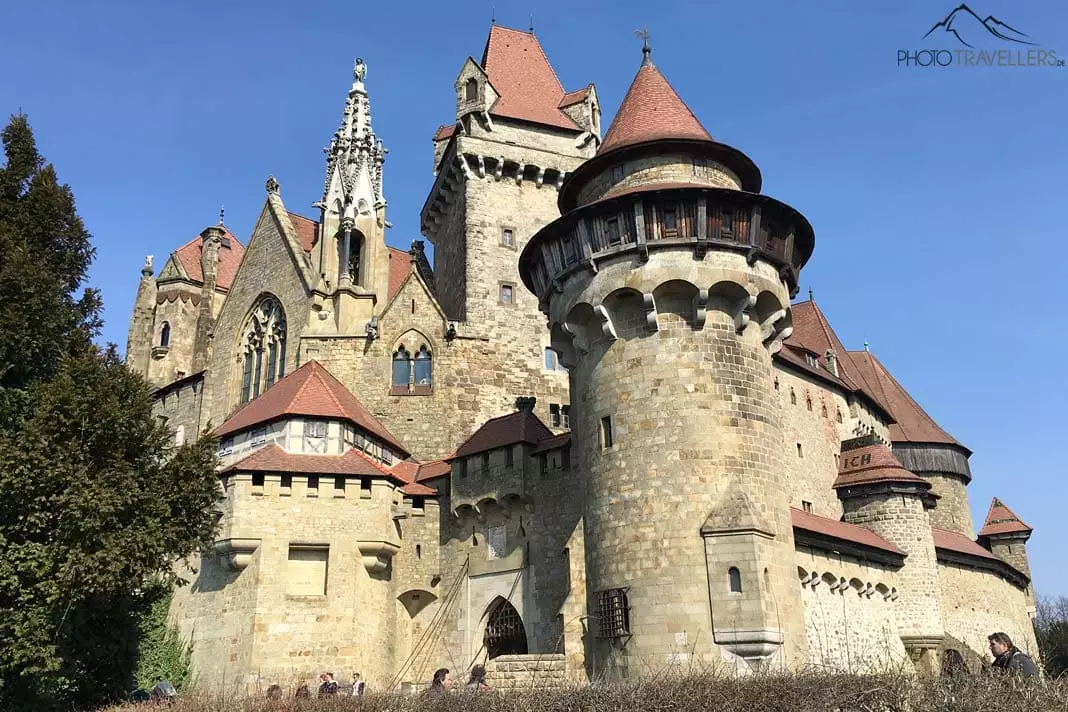
Vienna tips in a video
Here you can find our Vienna tips in compressed form as a Youtube video. Have fun watching.
Vienna City Card and Vienna Pass
No matter what time of year: A city trip to Vienna is always worthwhile. There really are countless sights to discover and if you’ve had enough of strolling through the city, sit down in one of the many cafés and enjoy a hot chocolate and a piece of Sacher cake. The parks, museums, and palaces are truly impressive. Of course, this is especially true of Schönbrunn Palace, which really no visitor can pass by. Or just stroll around a bit and let the city take effect on you. There really is something to discover everywhere.
However, a trip to the Danube metropolis is not cheap. With the Vienna City Card, you can at least save a little money. With the card, you can use buses and trains and get numerous discounts at museums, exhibitions, theaters or concerts, shopping, cafes, restaurants, or at the Heurigen, the wine taverns of the city. Here you can order the Vienna City Card*.
There is also the Vienna Pass. It’s more expensive but includes free admission to numerous sights such as Schönbrunn Palace, the Ferris wheel, the Belvedere, or the Hofburg. In addition, you can use the Hop-On/Hop-Off buses for free. You can order the Vienna Pass here*.
